In honor of Hispanic Heritage Month, we recognize Hispanic astronauts who have flown to the International Space Station (ISS) and contributed to its assembly, operations, and research activities. They were preceded in space by other pioneers. The first person in space of Hispanic heritage was Arnaldo Tamayo Méndez of Cuba who spent eight days aboard the Salyut-6 space station in 1980 as part of the Soviet Union’s Interkosmos program to fly cosmonauts from friendly socialist countries. The first Hispanic-American in space was Franklin R. Chang-Díaz when he flew as a mission specialist aboard Space Shuttle Columbia’s STS-61C mission in 1986. He flew in space a record-tying six more times, including one visit to the Russian space station Mir and one to ISS.
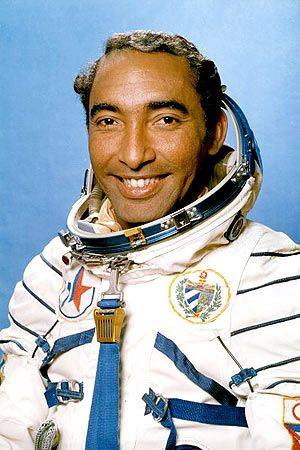
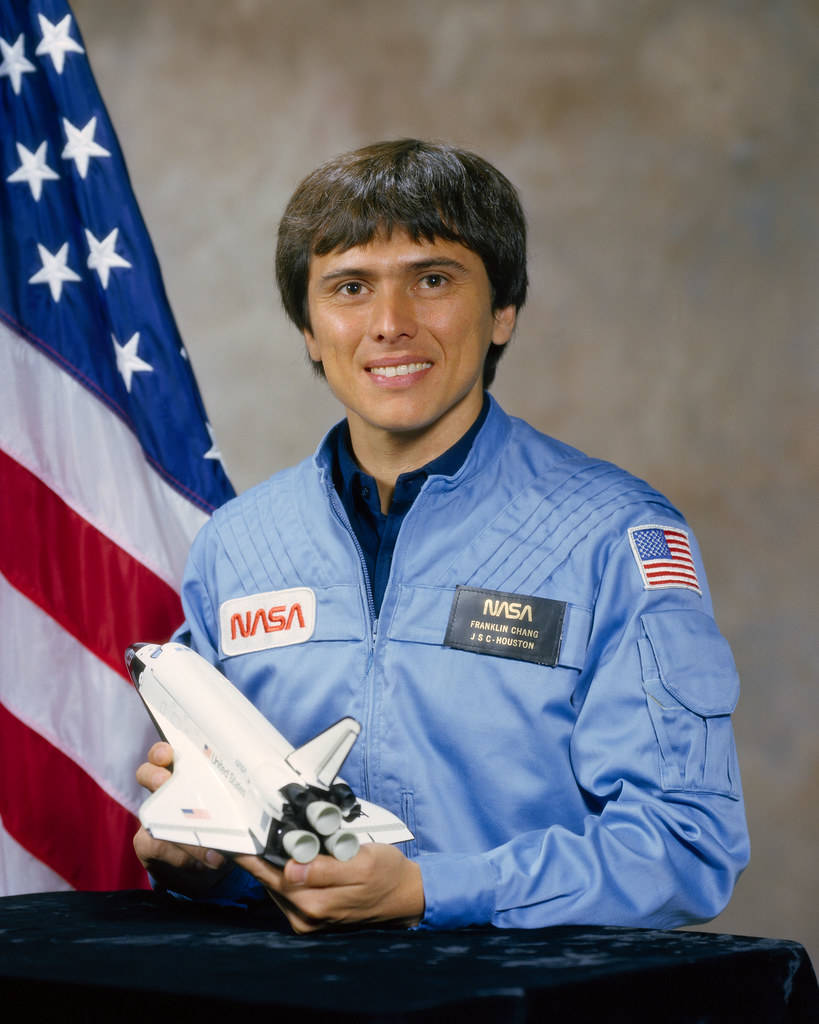
Left: Portrait of Tamayo Méndez.
Right: Portrait of Chang-Díaz.
In this article, we recognize the American astronauts of Hispanic heritage who have flown aboard ISS, contributing to its construction and operation and conducting the world-class research for which the station is known. The table below lists these individuals and others of different nationalities who have similarly shared in this remarkable international adventure.

Table of Hispanic astronauts who have visited ISS.
The honor of being the first Hispanic astronaut to fly to ISS belongs to Ellen L. Ochoa, selected by NASA in 1990 as the first female Hispanic astronaut. She had already completed two spaceflights, STS-56 in 1993 and STS-66 the following year, before making her first visit to ISS in 1999 as a mission specialist aboard Discovery’s STS-96. The goals of the mission, only the second shuttle flight to ISS that at the time comprised only two modules, included the transfer of two tons of logistics to the station, launched inside a Spacehab double module, and the delivery of the Russian Strela cargo crane.
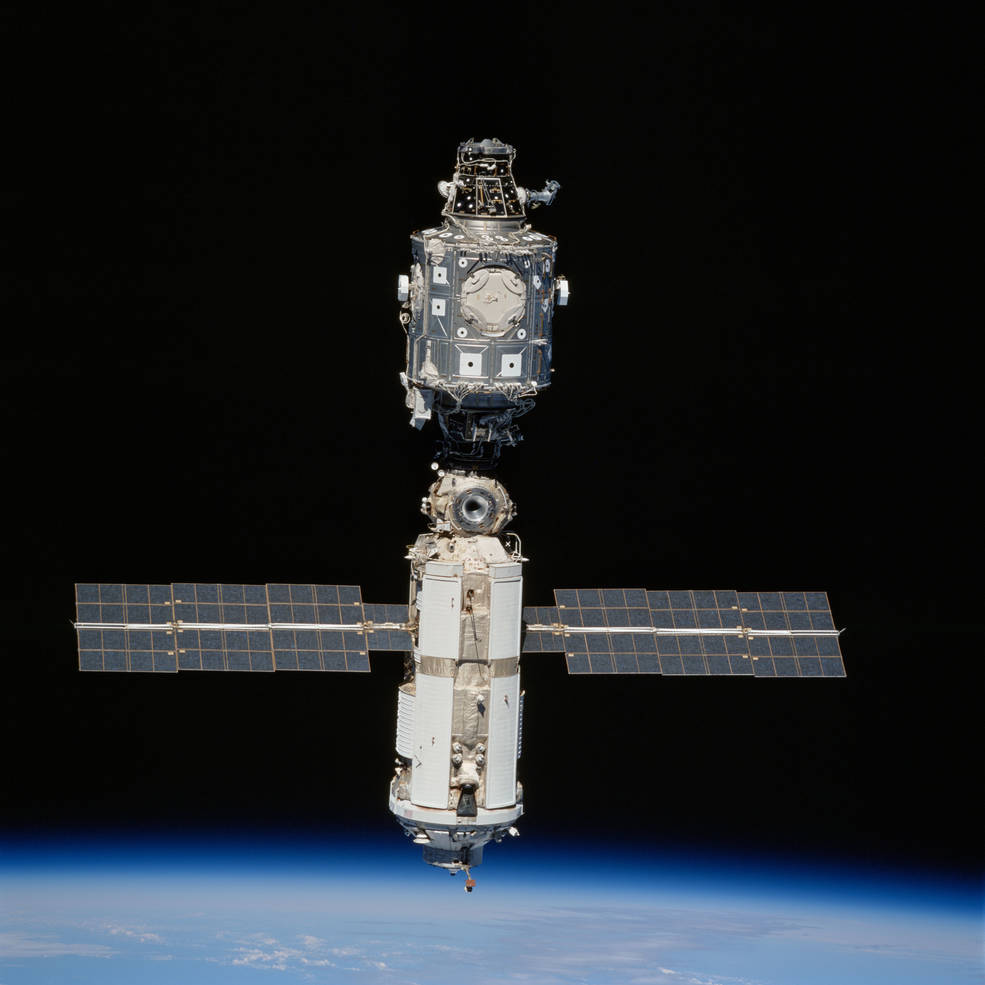
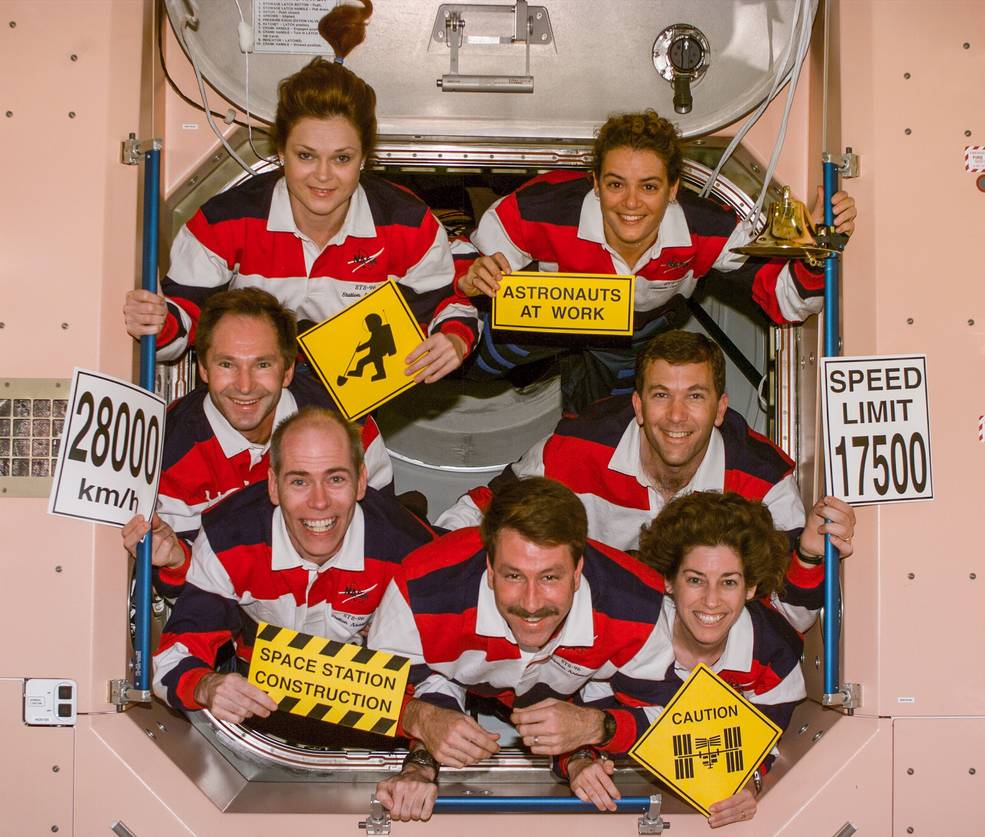
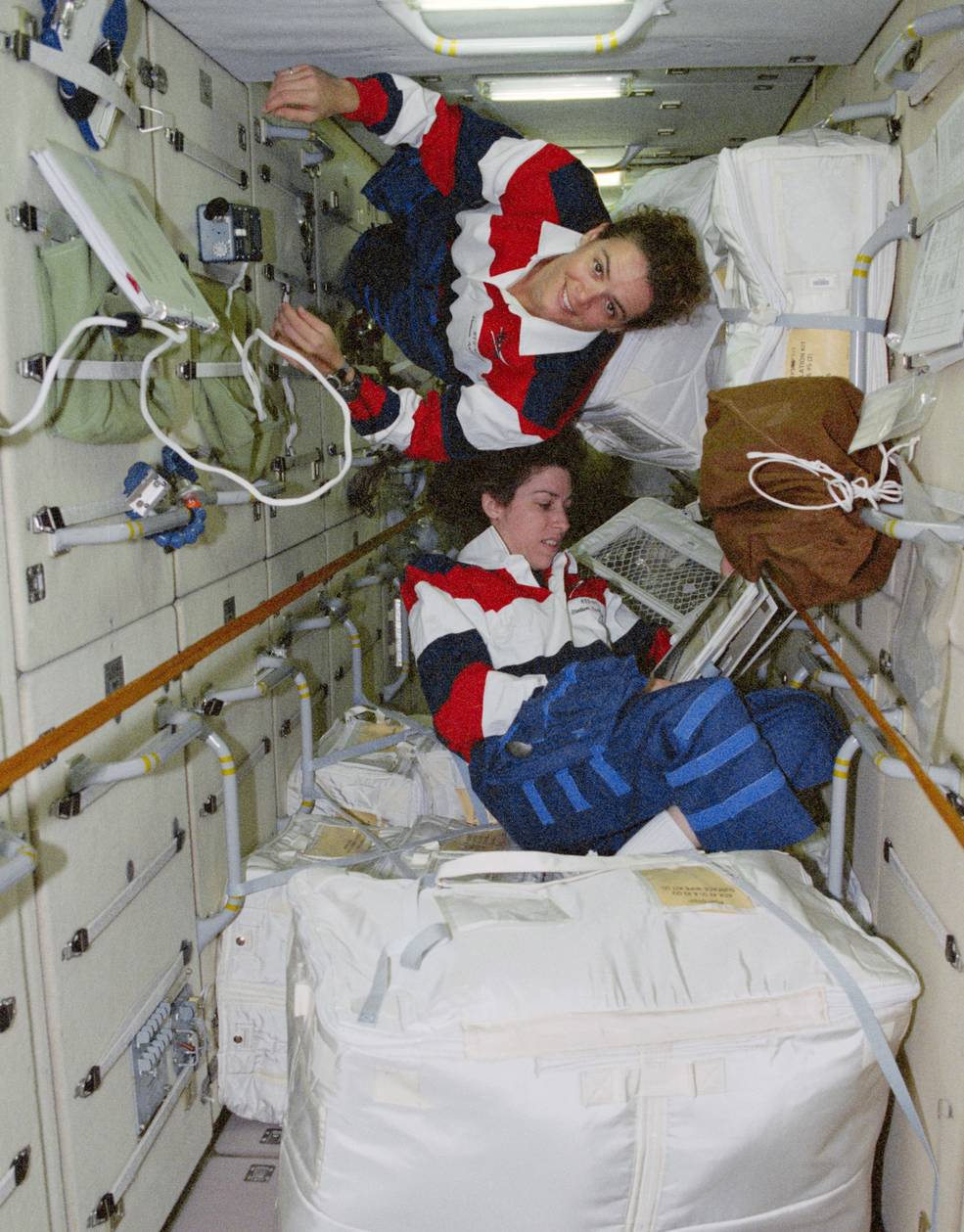
Left: ISS as seen from STS-96.
Middle: Ochoa, lower right, with the STS-96 crew in the Unity Node 1.
Right: Ochoa, bottom, with fellow STS-96 crewmembers Julie Payette in the Zarya module.
Ochoa returned to a much-enlarged ISS aboard Atlantis in April 2002 during the STS-110 mission that delivered the 13-ton S0 truss, the center segment section to which future truss segments were attached. Ochoa operated the Space Station Remote Manipulator System (SSRMS) also known as Canadarm2 to lift S0 from the shuttle’s payload bay and attach it atop the Destiny module. The S0 truss also contained the Mobile Transporter to allow the SSRMS to translate up and down the trusses. Ochoa was named as the Johnson Space Center’s (JSC) Deputy Director in 2007, then as JSC’s first Hispanic Director in 2013. She served in that position until her retirement from NASA in 2018.
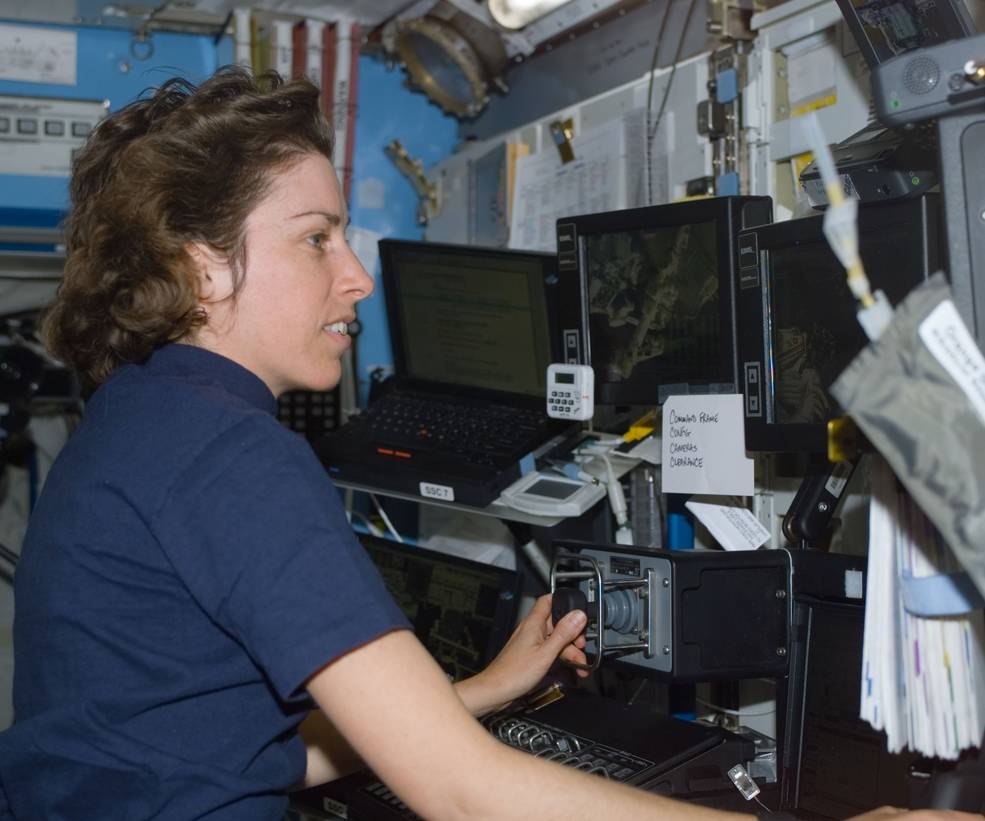
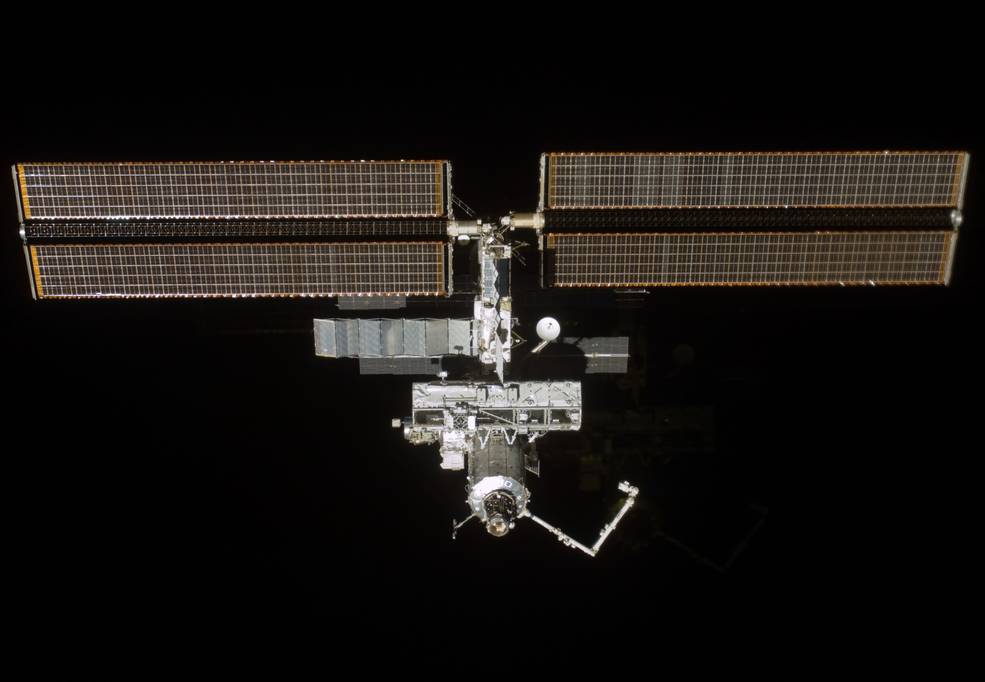
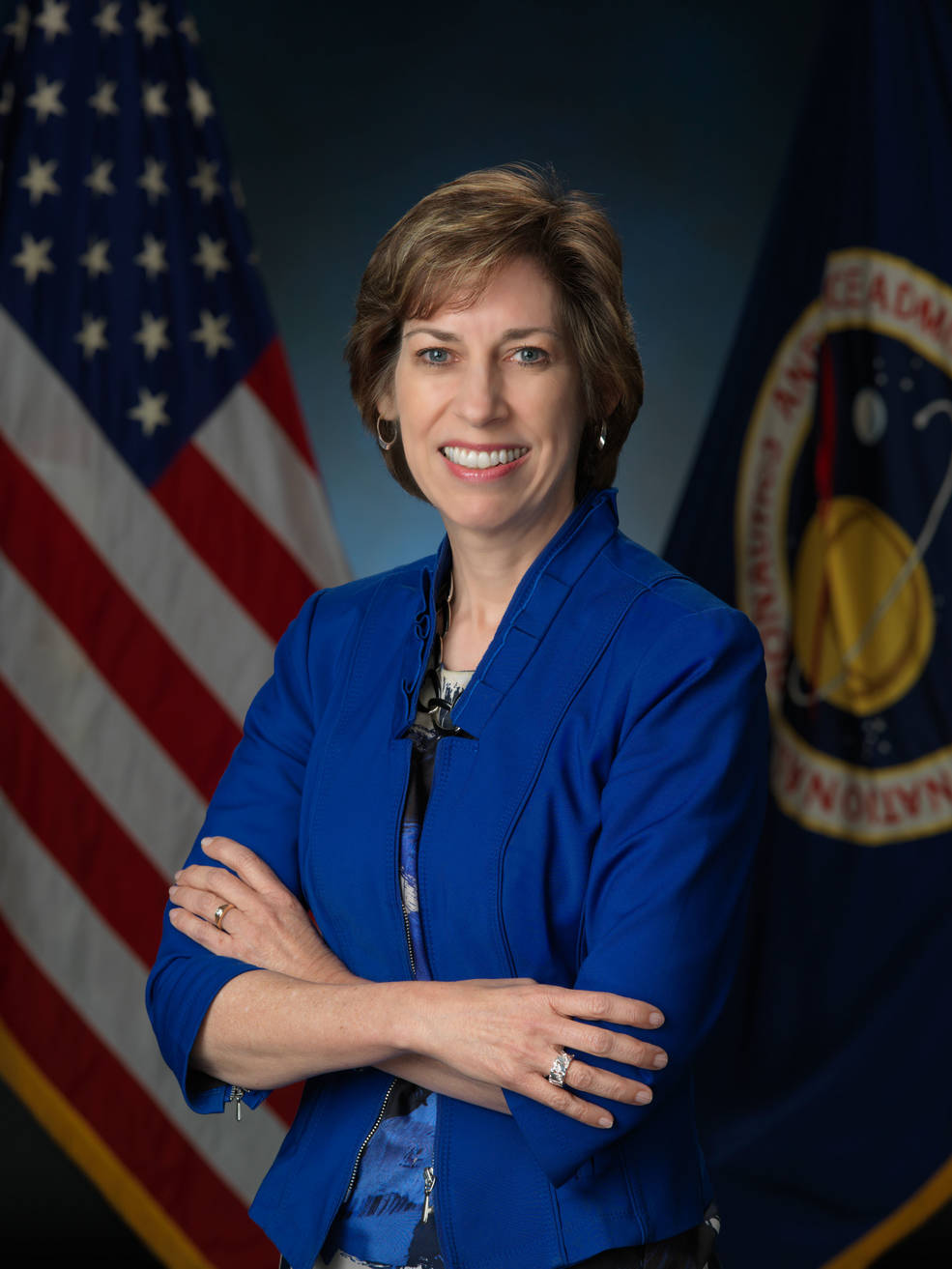
Left: Ochoa operating Canadarm2 in the Destiny module.
Middle: ISS as seen from the departing STS-110, showing the S0 truss mounted on Destiny.
Right: Ochoa as JSC Director.
NASA selected Michael E. “LA” Lopez-Alegria, born in Madrid, Spain, as an astronaut in 1992. Already a veteran of STS-73, the second mission of the United States Microgravity Laboratory, Lopez-Alegria served as a mission specialist on STS-92 during his first visit to ISS. He and his six crewmates launched aboard Space Shuttle Discovery on Oct. 11, 2000, the 100th launch of the program and the last to visit an unoccupied ISS. At the time, the station comprised just three modules: the Zarya Functional Cargo Block (FGB), the Unity Node 1 and the Zvezda Service Module, the latest addition to the station having arrived just three months prior. During their mission, the STS-92 crew installed the Z1 Truss atop the Unity module, four Control Moment Gyros, and the third Pressurized Mating Adaptor (PMA-3). The Z1 was the first truss element added to ISS to allow for the addition of solar arrays and radiators on the subsequent assembly flight and also contained high-rate communications equipment, including the first Space-to-Ground Antenna (SGANT). Lopez-Alegria participated in two of the mission’s four Extravehicular Activities (EVAs), or spacewalks, with Peter J. “Jeff” Wisoff to complete the assembly tasks. During their last EVA, the two conducted the first flight evaluation of the Simplified Aid for EVA Rescue (SAFER) at ISS, a propulsive backpack to be used by astronauts should they become detached from the spacecraft. The STS-92 crew undocked from ISS on Oct. 20, 2000, leaving the station ready for its first inhabitants, and indeed less than two weeks later, the first Expedition crew arrived to begin permanent occupancy of low Earth orbit.
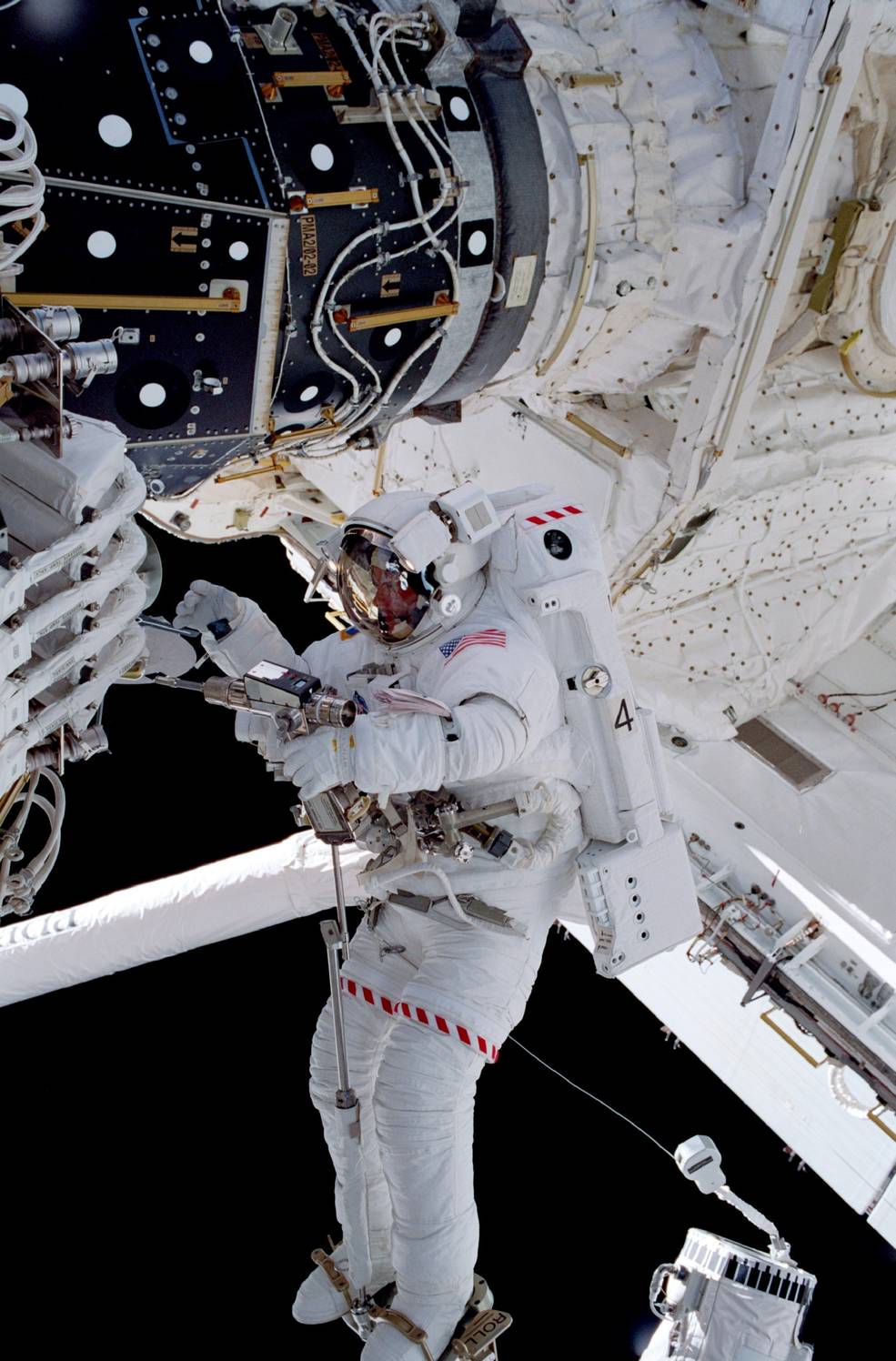
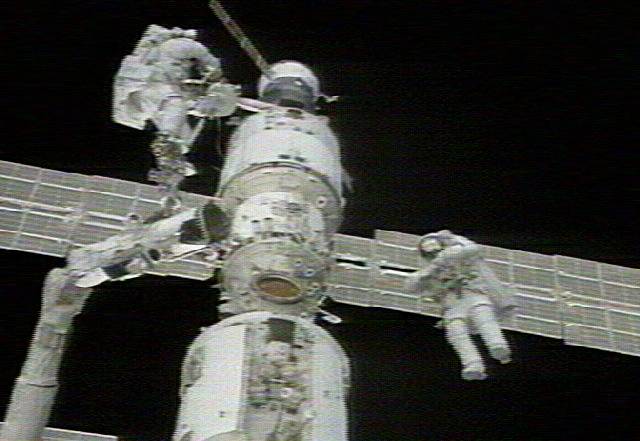
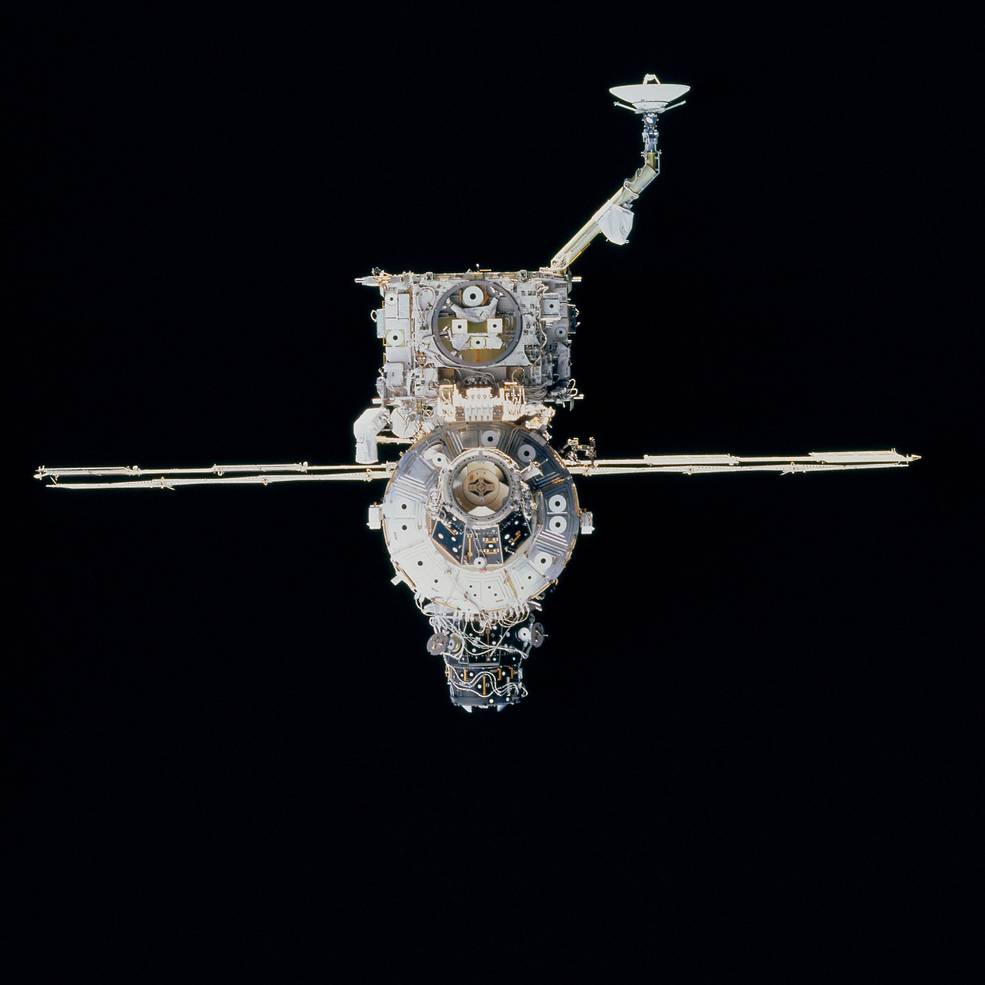
Left: Lopez-Alegria working outside ISS during STS-92.
Middle: Lopez-Alegria, left, flies the SAFER as Wisoff looks on.
Right: ISS seen from Discovery shortly after undocking, showing the Z1 Truss with the SGANT at top and PMA-3 at bottom.
For his third flight into space, Lopez-Alegria returned to ISS in 2002 during the STS-113 mission, the station now permanently occupied and having grown significantly in the intervening two years. The primary tasks for the STS-113 crew included adding the P1 truss on the station’s port side, installing the Crew Equipment Translation Aid (CETA) cart, and assisting the exchange between the Expedition 5 and 6 crews. Lopez-Alegria and fellow STS-113 mission specialist John B. Harrington conducted three EVAs to complete the installation of the P1 truss and the CETA cart. After STS-113, assembly of ISS came to a temporary halt following the Columbia accident on Feb. 1, 2003, and the subsequent grounding of the space shuttle fleet and did not resume until September 2006.
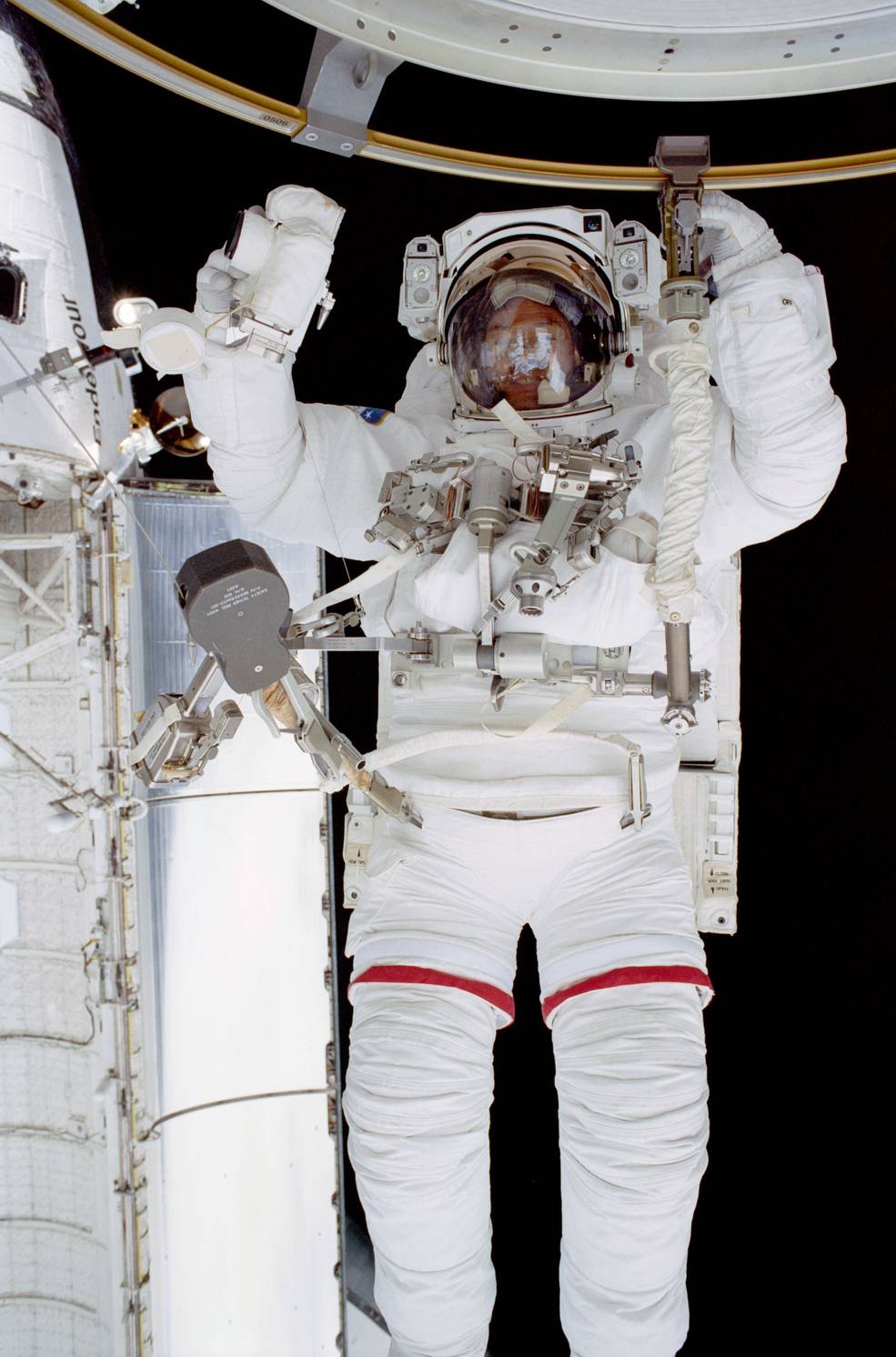
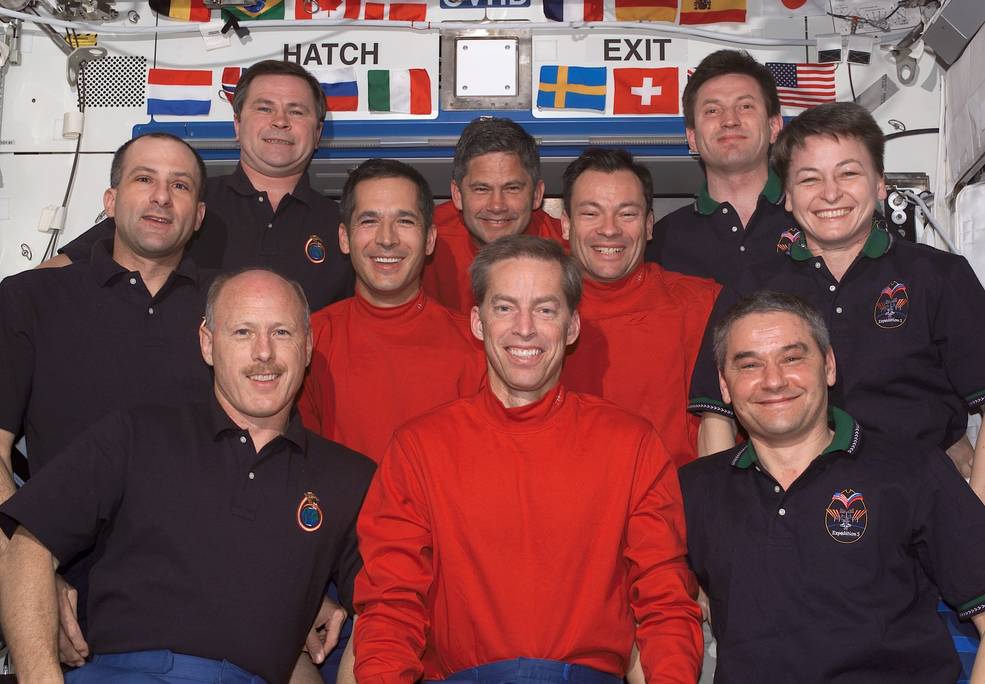
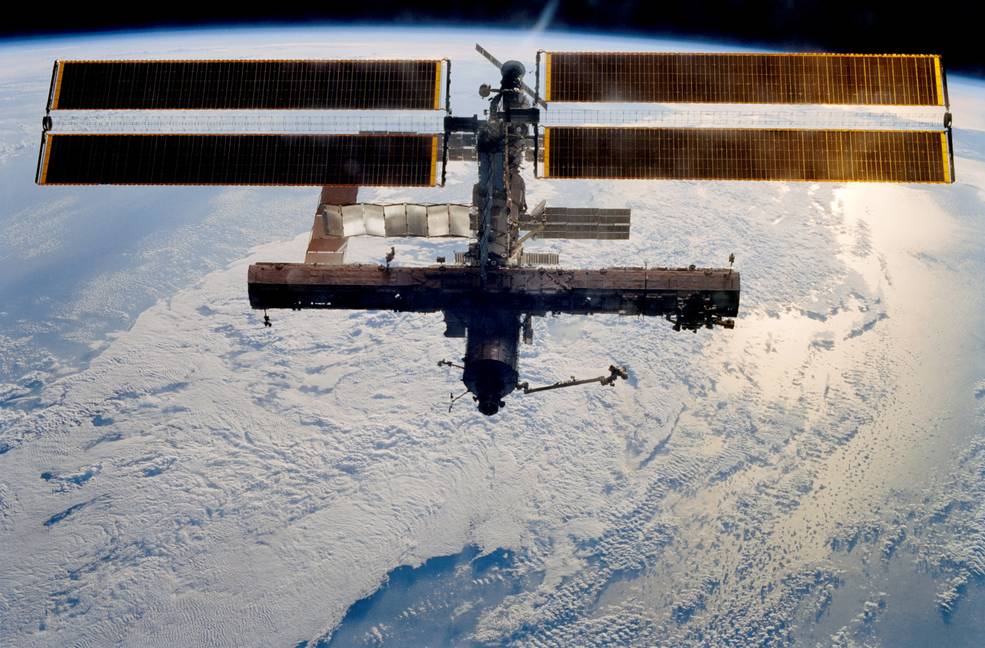
Left: Lopez-Alegria during the first STS-113 EVA.
Middle: Lopez-Alegria, second from right in the middle row, posing in the Destiny module with his STS-113 crewmates, as well as Expedition 5 and 6 crewmembers.
Right: ISS as seen by the departing STS-113 crew, with the newly installed P1 truss visible at right.
Lopez-Alegria was aboard ISS again shortly after assembly resumed. He launched aboard Soyuz TMA9 on Sept. 18, 2006, from the Baykonur Cosmodrome in Kazakhstan, his fourth and final spaceflight. Accompanying him during the 215-day mission, to that time the longest ISS expedition, was Mikhail V. Tyurin. On the station, European Space Agency (ESA) astronaut Thomas A. Reiter, onboard since July 2006, became part of the Expedition 14 crew. As Commander of Expedition 14, Lopez-Alegria oversaw one of the most complex set of activities in the assembly of ISS – the reconfiguration of its power and cooling systems. A week before his arrival on ISS, the STS-115 mission had delivered the second set of solar arrays to the station as part of the P3/P4 truss segment, positioning them outboard of the P1 segment. As part of the reconfiguration, the port side P6 array mounted atop the Z1 truss needed to be retracted to prevent interference with the rotation of the new arrays, a task that was completed during the visiting STS-116 mission in December that also added the P5 short spacer to the port side truss. That mission brought Sunita L. “Suni” Williams to ISS as a new addition to Expedition 14 and returned Reiter back to Earth. During Expedition 14, Lopez-Alegria took part in five EVAs, two in Orlan space suits to conduct work on the outside of the Russian segment with Tyurin and three in American Extravehicular Mobility Units with Williams to reconfigure the cooling system of the US segment. He accumulated a total of 67 hours and 40 minutes over 10 EVAs, still the record among American astronauts. When not busy assembling and reconfiguring ISS, Lopez-Alegria conducted a variety of scientific experiments. Lopez-Alegria and Tyurin returned to Earth on April 21, 2007, leaving Williams on board ISS with the Expedition 15 crew. Across his four missions, Lopez-Alegria spent a cumulative 258 days in space.
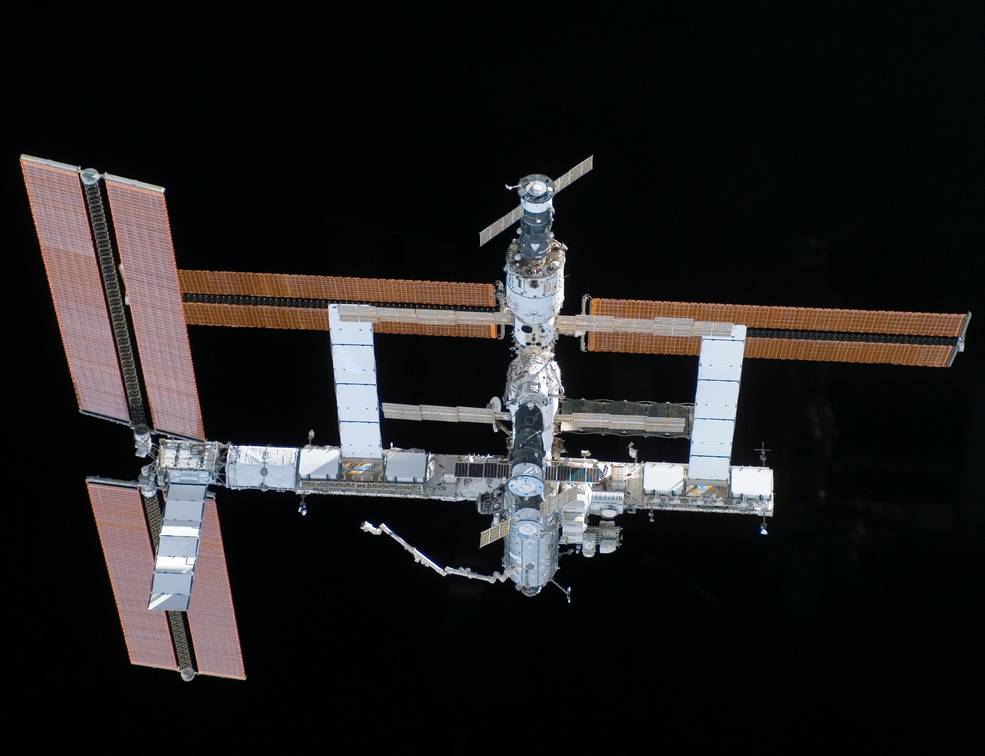
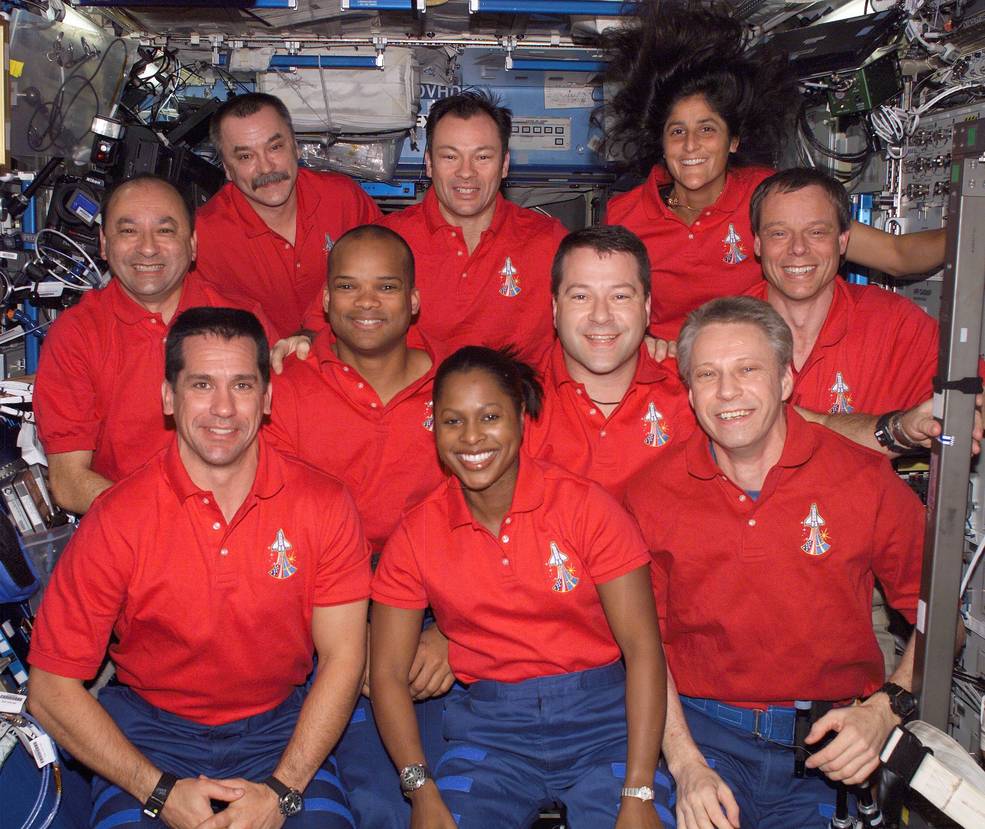
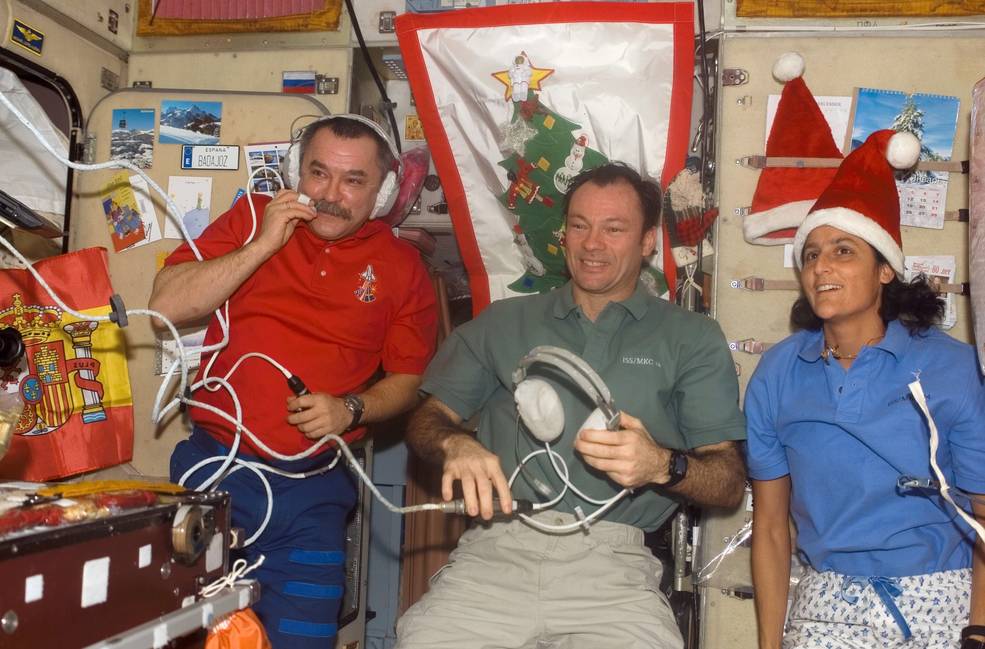
Left: ISS configuration when Lopez-Alegria arrived in Sept. 2006.
Middle: Lopez-Alegria, back row middle, with STS-116 and Expedition 14 crewmembers.
Right: Celebrating the holidays aboard ISS.

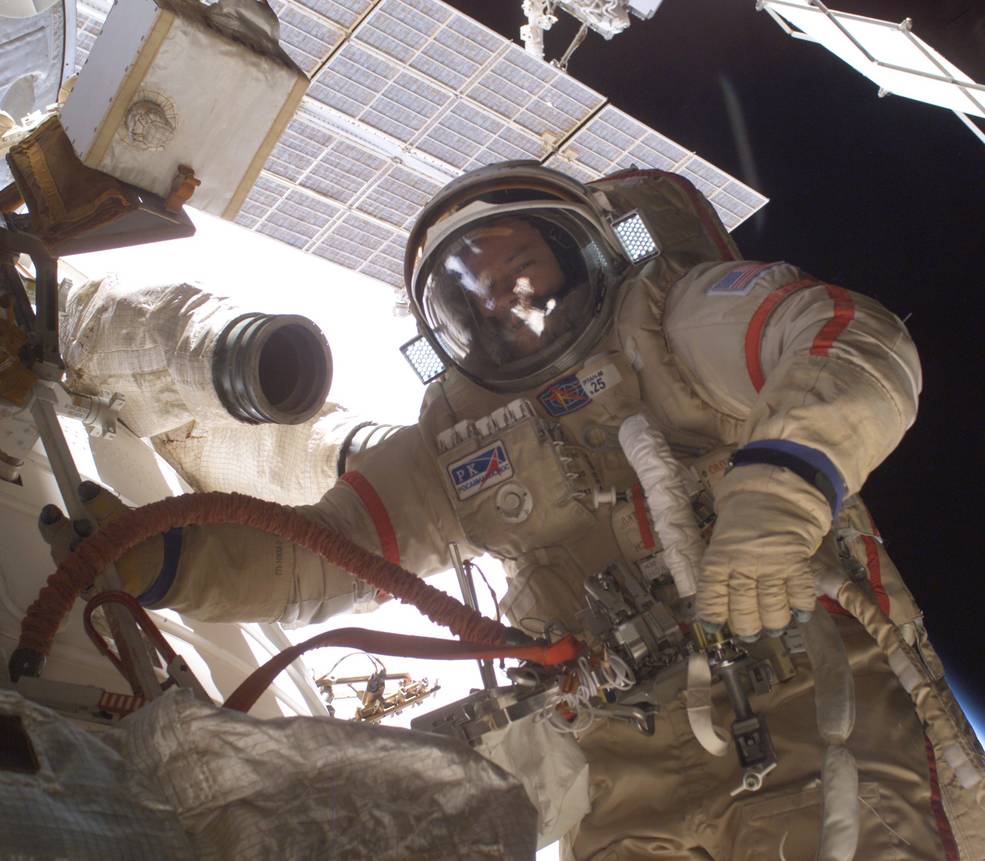
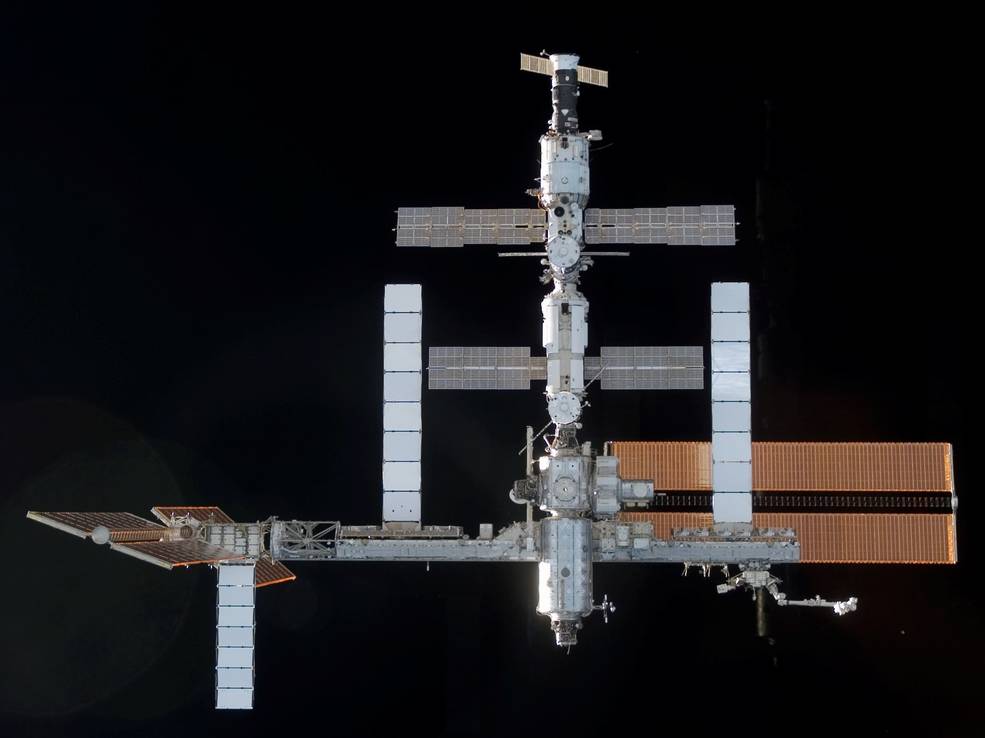
Left: Lopez-Alegria conducting a session of the Canadian TRAC experiment in the Destiny module.
Middle: In an Orlan suit, Lopez-Alegria conducts maintenance on the exterior of the Russian segment.
Right: The ISS configuration at the end of Lopez-Alegria’s mission – note the retracted P6 solar array.
Carlos I. Noriega was the first Peruvian-born astronaut, selected by NASA in 1994. His visit to ISS in 2000 marked the second time he saw the inside of a space station. On his first spaceflight in 1997, he was a mission specialist aboard STS-84, the sixth Shuttle-Mir docking mission. On Dec. 1, 2000, he launched aboard Endeavour with his four crewmates on the STS-97 mission, their primary goal to install the P6 truss segment with the first set of solar arrays and radiators atop the Z1 truss, delivered on the previous mission. STS-97 marked the first time a shuttle visited ISS after it was occupied, but given the busy EVA schedule, the hatches between the two vehicles were only open for 24 hours. Noriega and fellow mission specialist Joseph R. Tanner conducted three EVAs to complete the P6 installation and other assembly tasks. The new solar arrays generated enough power for the arrival of the US laboratory module Destiny early in 2001 and the start of intensive research aboard ISS.
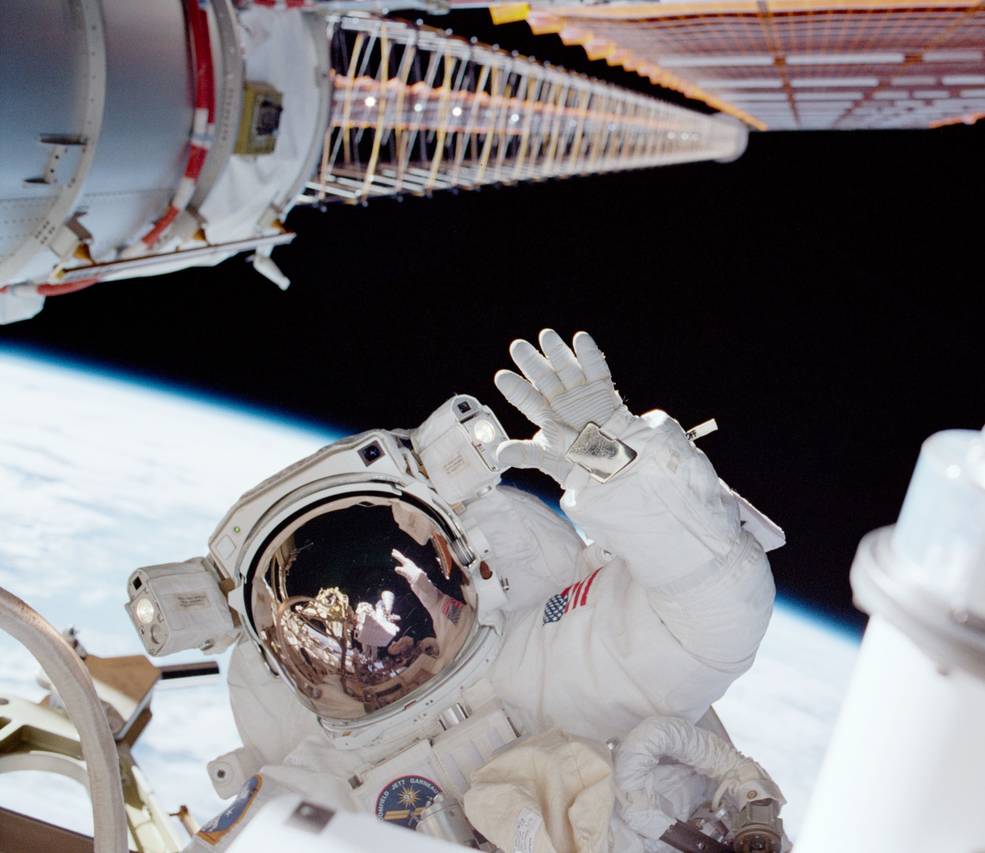
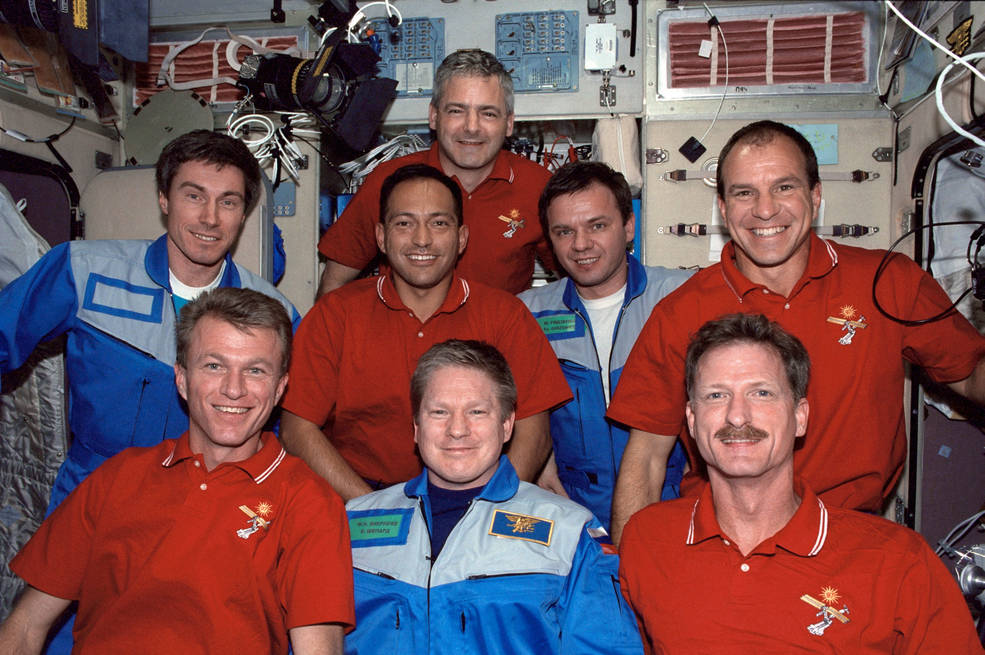
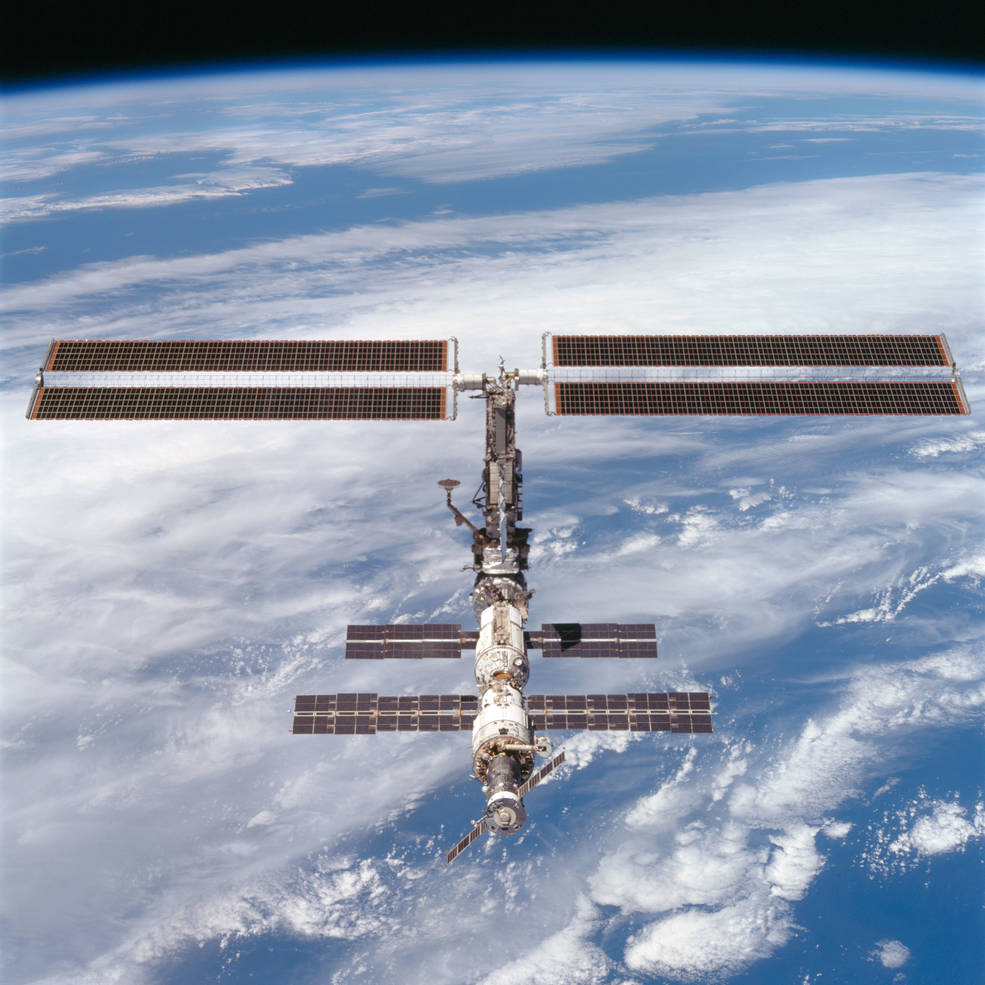
Left: Noriega waves to the camera as he installs the P6 truss and solar arrays.
Middle: Noriega, center, with the STS-97 and Expedition 1 crews in the Zarya Service Module.
Right: The ISS as seen from the departing STS-97 showing the newly deployed P6 solar arrays.
During his record-tying seventh trip into space, Costa Rica-born Franklin R. Chang-Díaz made his only visit to ISS. The main goals of Endeavour’s STS-111 mission, launching on June 5, 2002, included the exchange of the Expedition 4 and 5 crews and the resupply of ISS using the Leonardo Multi-Purpose Logistics Module (MPLM). Two new research facilities were among the MPLM’s cargo, the fifth Expedite the Processing of Experiments to the Space Station (EXPRESS) rack and the Microgravity Sciences Glovebox (MSG). Chang-Díaz completed three EVAs with fellow mission specialist French astronaut Philippe Perrin to install the Mobile Base System portion of the Canadarm2’s remote manipulator system and perform maintenance tasks on the station.
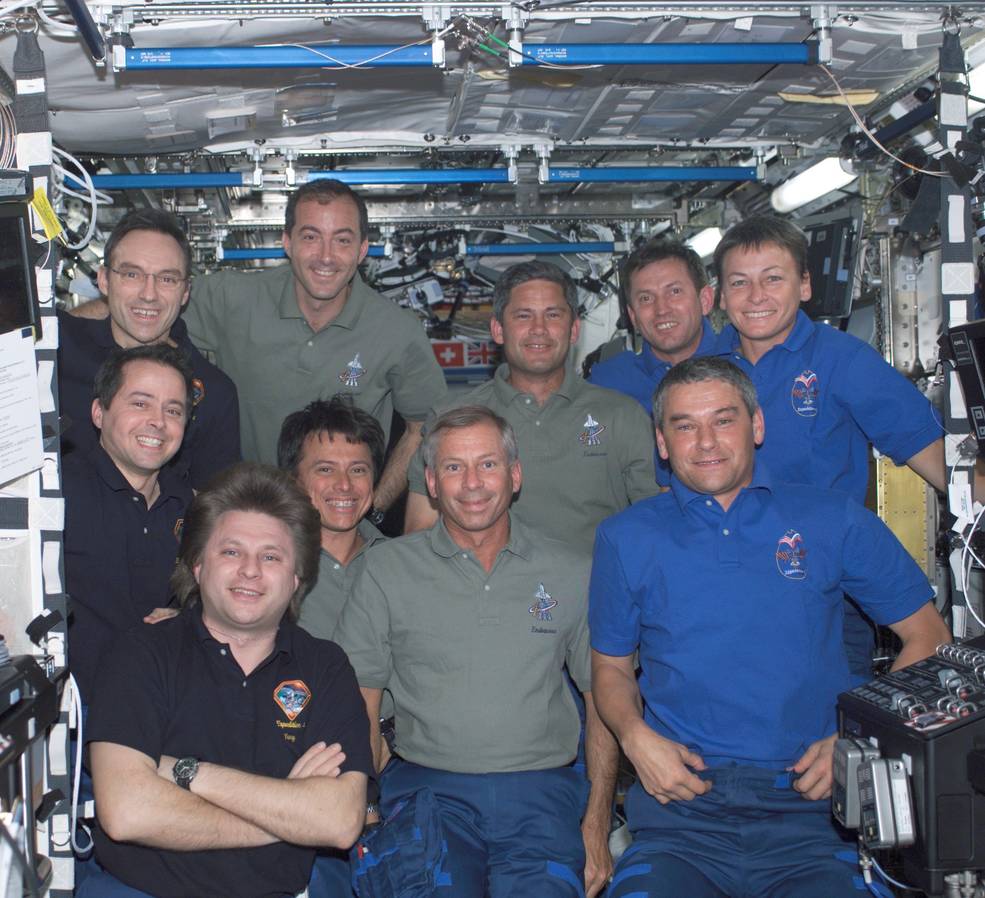
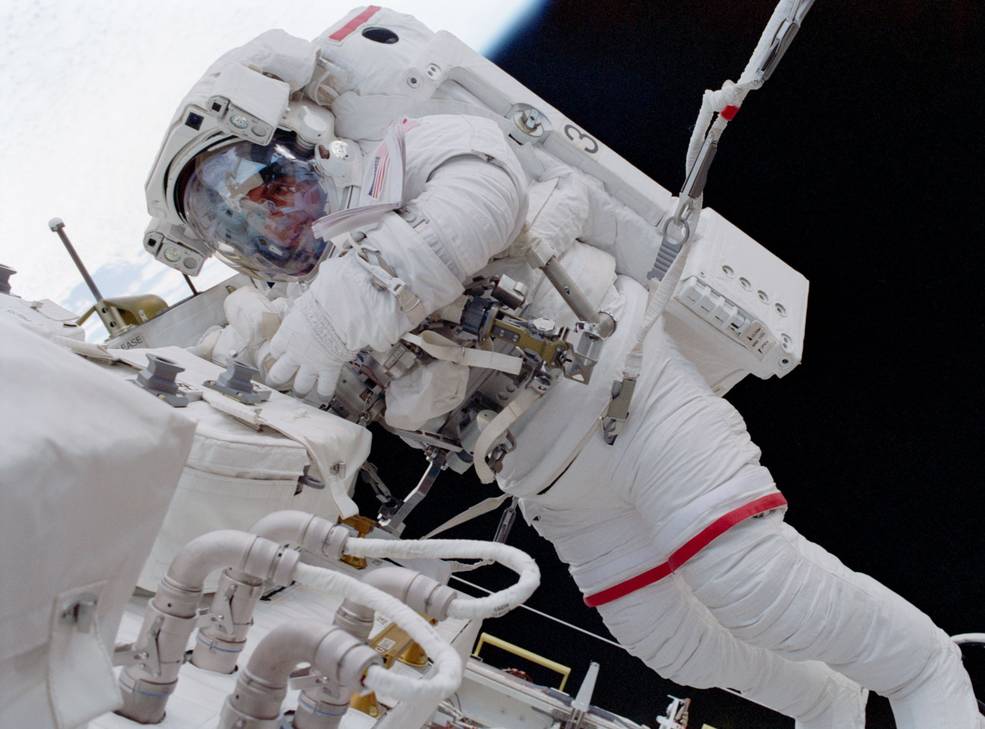
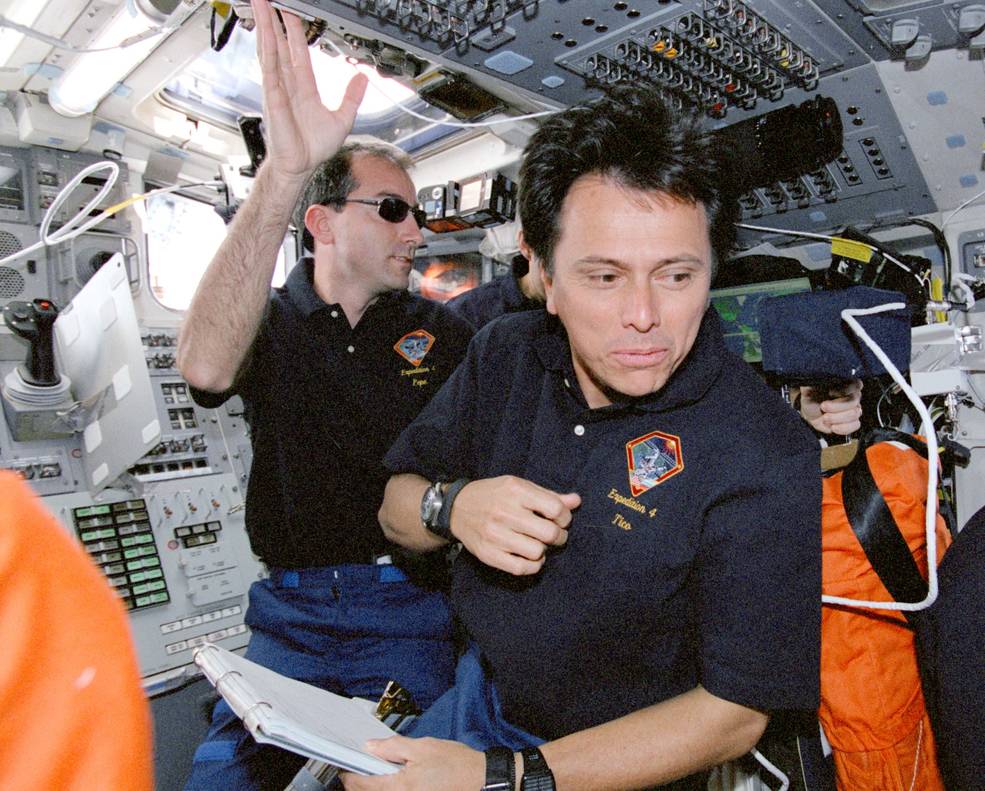
Left: Chang-Díaz, left of center, with his STS-111 crewmates and the Expedition 4 and 5 crews.
Middle: Chang-Díaz during the first STS-111 EVA.
Right: Chang-Díaz in Endeavour’s middeck following undocking from ISS.
Selected as a member of NASA’s Astronaut Class of 1998, John D. “Danny” Olivas has visited ISS on two occasions as a shuttle mission specialist. His first visit took place aboard Atlantis during the STS-117 mission launched on June 8, 2007. During the flight, Olivas and fellow mission specialist James F. Reilly conducted two of the four EVAs to install the S3/S4 truss segment that included the third set of solar arrays. To prevent interfering with the rotation of the new arrays, the crew retracted the starboard P6 array mounted atop the Z1 truss. That truss segment was relocated outboard of the P5 truss on a later mission. The STS-117 mission also served as a crew exchange flight, with Clayton C. Anderson replacing Suni Williams as a member of Expedition 15.
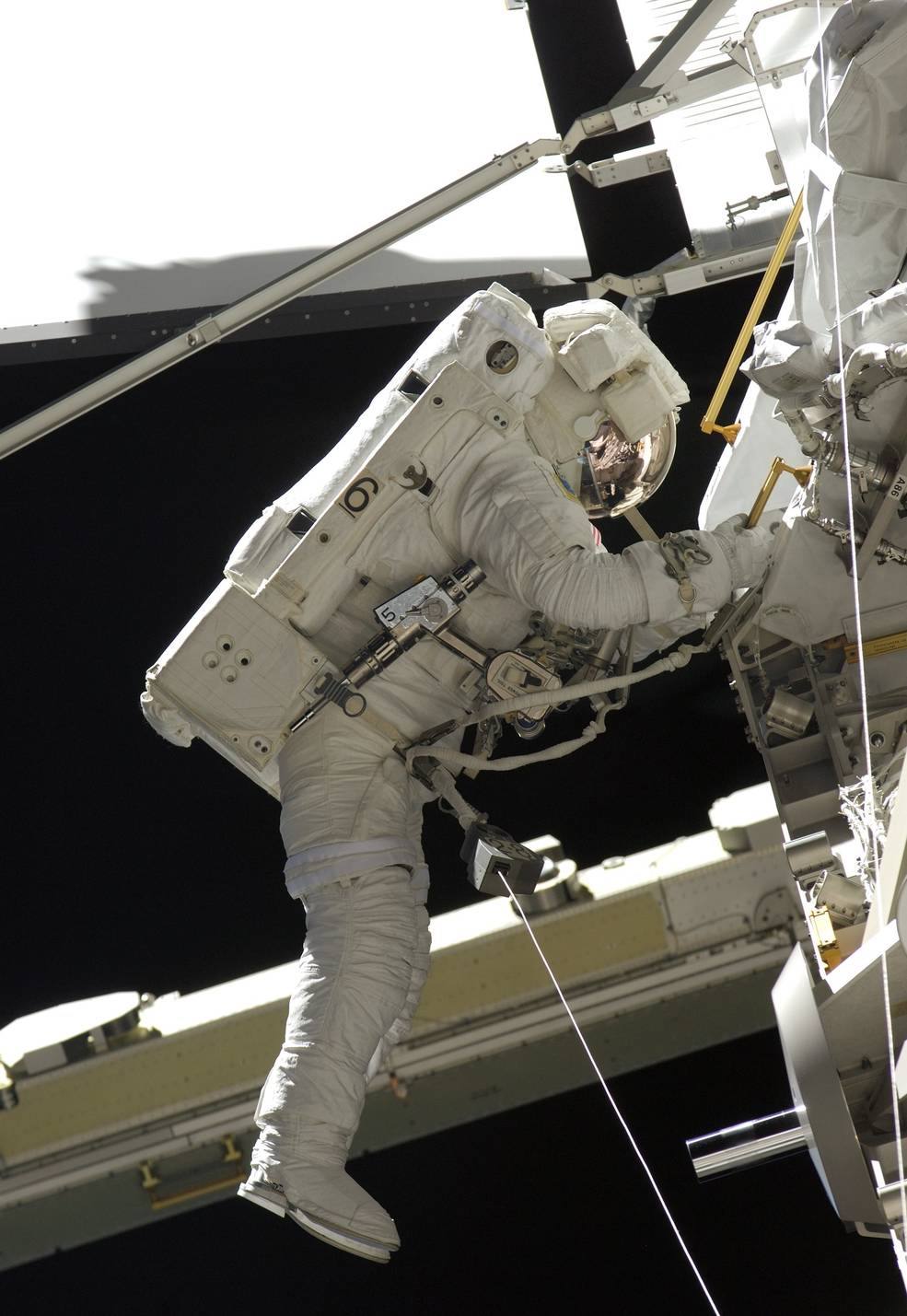
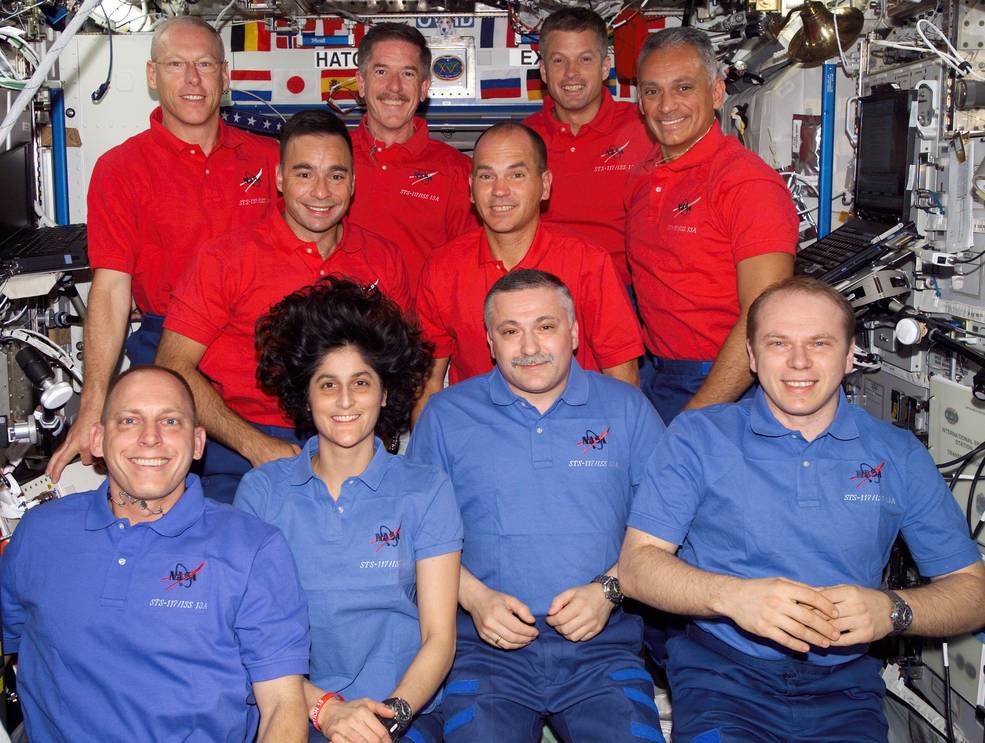
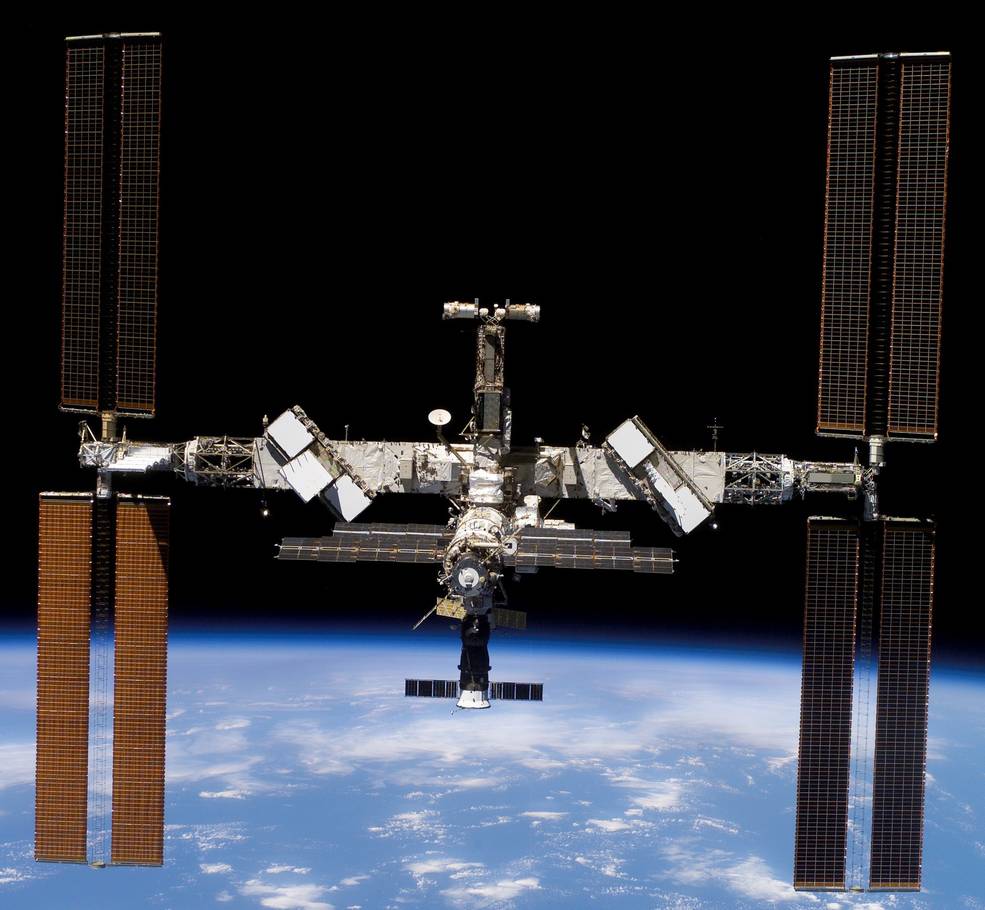
Left: Olivas during an STS-117 EVA working on the S3/S4 truss installation.
Middle: Olivas, back row at right, with STS-117 and Expedition 15 crews.
Right: ISS as seen from the departing STS-117 crew, showing the new set of starboard solar arrays at right.
On his return to ISS, Olivas found it a bit more crowded – three months earlier, the permanent crew aboard the station had expanded from three to six. He and his crewmates launched aboard Discovery on the STS-128 mission on Aug. 29, 2009. The shuttle’s payload bay contained the MPLM Leonardo bringing supplies to help maintain a 6-person crew on ISS, including three systems racks – a Crew Quarters (CQ), an Air Revitalization System (ARS) rack, and the Combined Operational Load Bearing External Resistance Treadmill (COLBERT) for crew exercise – as well as three research racks – the Fluid Integrated Rack (FIR), the Materials Science Research Rack (MSRR), and the second Minus Eighty-degree Laboratory Freezer for ISS (MELFI). Olivas participated in three EVAs to replace the Ammonia Tank Assembly (ATA) on the P1 truss and to retrieve two experiments from the European Columbus module’s External Payload Facility. STS-128 also completed the final shuttle-based crew exchange, with Nicole P. Stott taking Timothy L. Kopra’s place as an Expedition 20 crewmember.
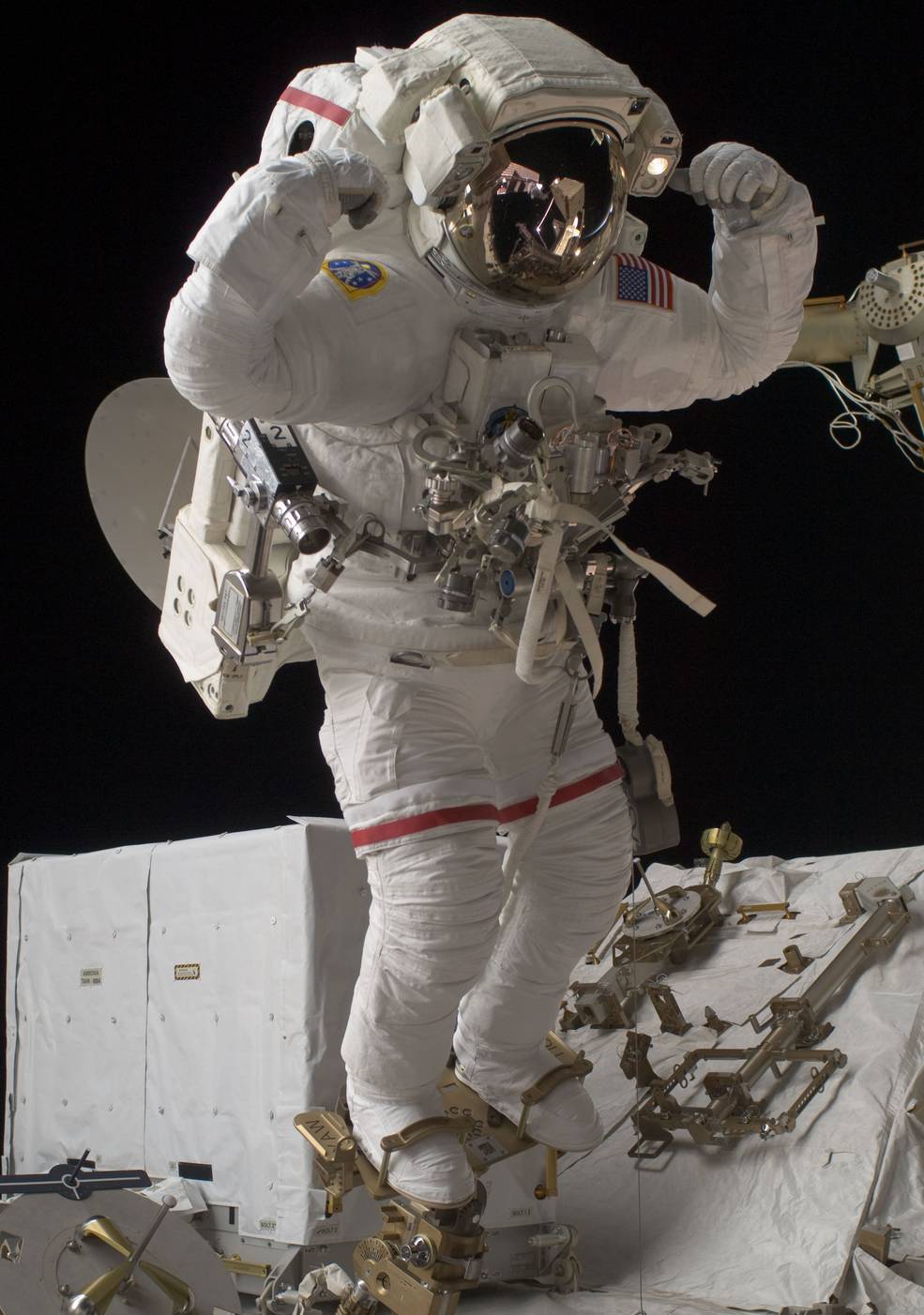
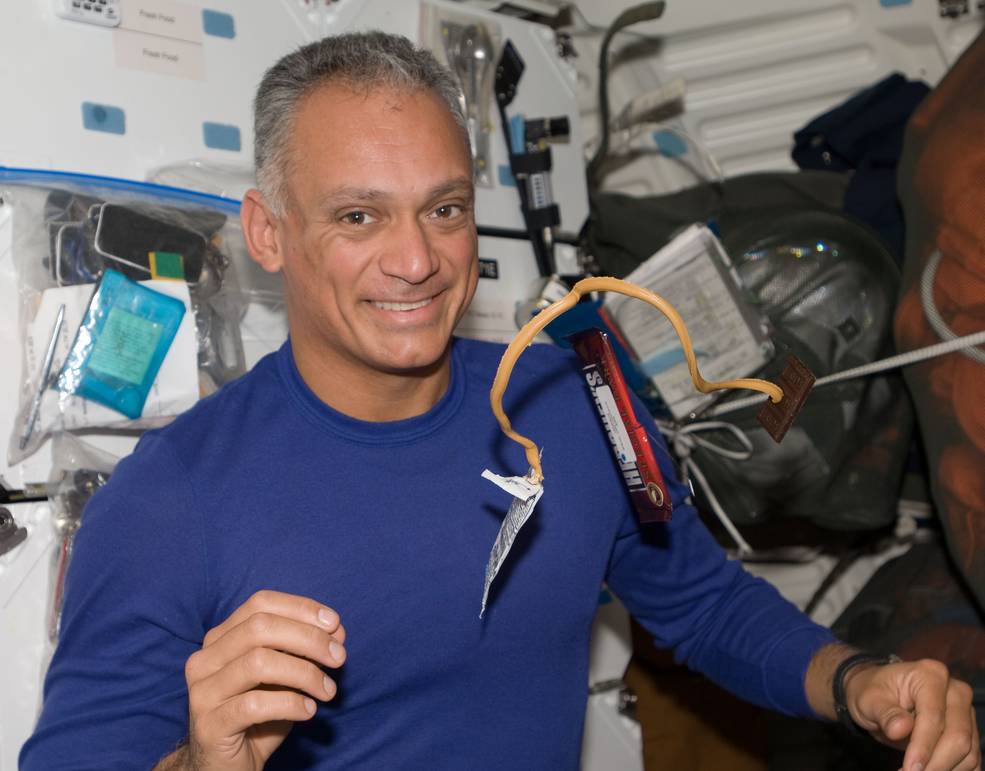
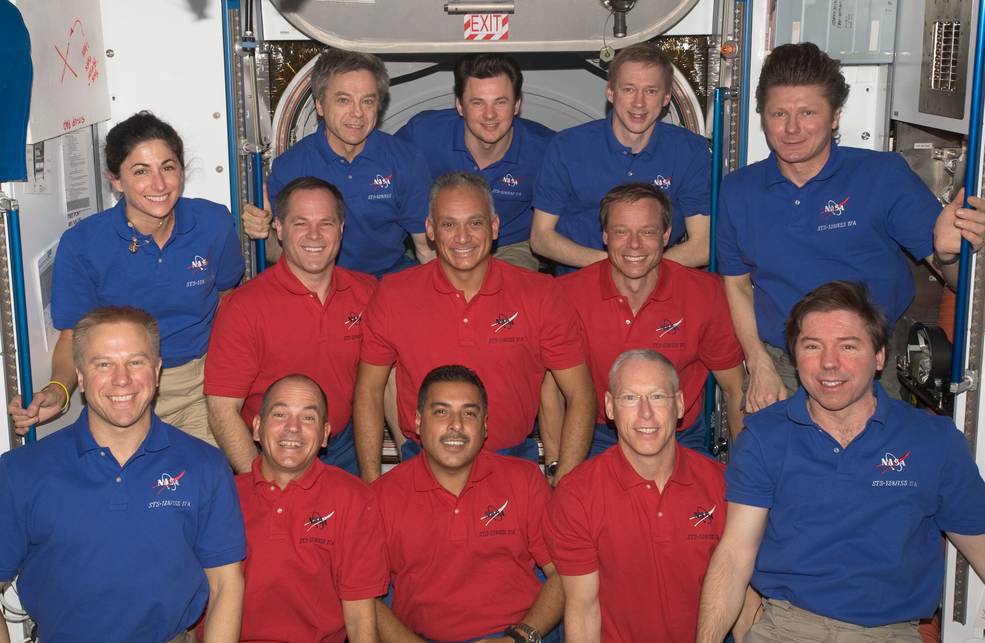
Left: Olivas pauses during EVA work on the ATA to strike a pose.
Middle: Olivas eating a chocolate and peanut butter snack.
Right: Olivas, at center, with STS-128 and Expedition 20 crews.
Selected as a NASA astronaut in 1998, George D. Zamka completed his first space flight as Pilot on Discovery’s STS-120 mission. Launching on Oct. 23, 2007, Zamka and his crewmates brought the Harmony Node 2 module to ISS, temporarily berthing it on the Unity Node 1’s port side until the Expedition 16 crew later relocated it to Destiny’s forward hatch. In its final location, Harmony enabled the installation of the European and Japanese elements. The crew also relocated the P6 truss segment from atop Z1 to the outboard port truss. During the redeployment of the P6 solar arrays, one of them developed a tear that required repair using a cufflink-like device to sew up the gap in the panel. STS-120 also conducted a crew exchange, with Daniel M. Tani taking Clay Anderson’s place as a member of Expedition 16. As the STS-120 Pilot, Zamka completed the undocking from ISS and the departure fly-around maneuver.
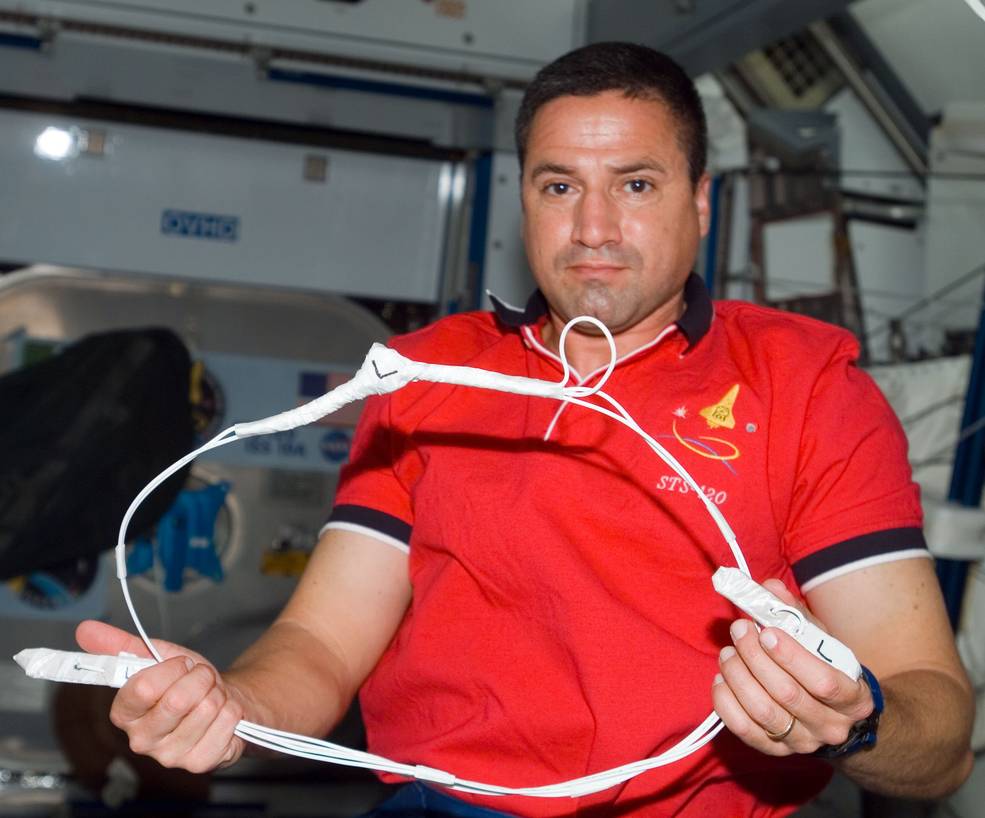
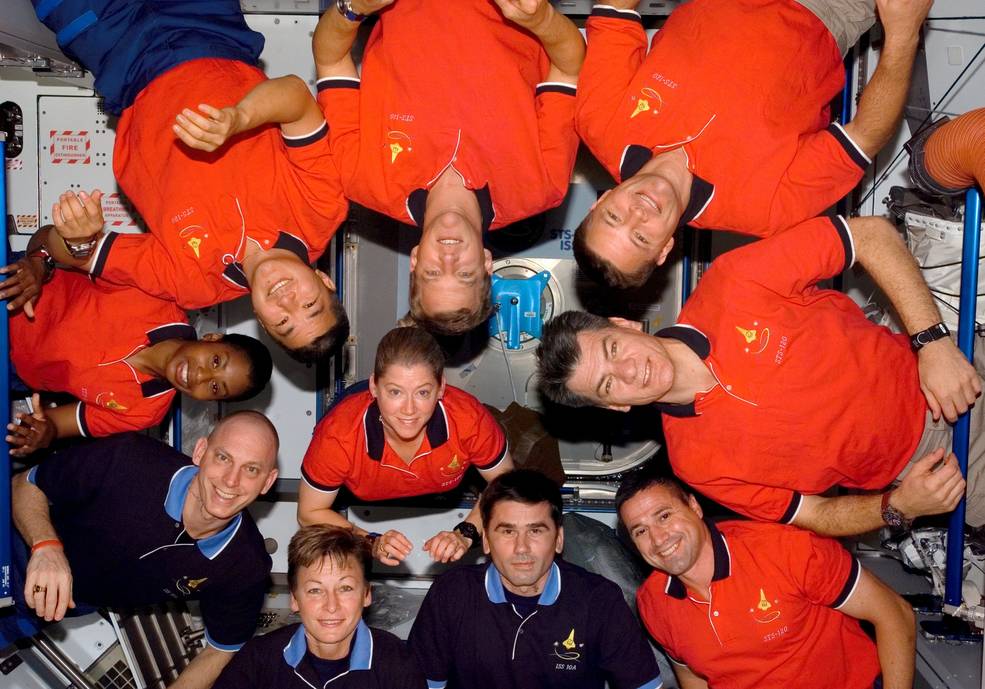
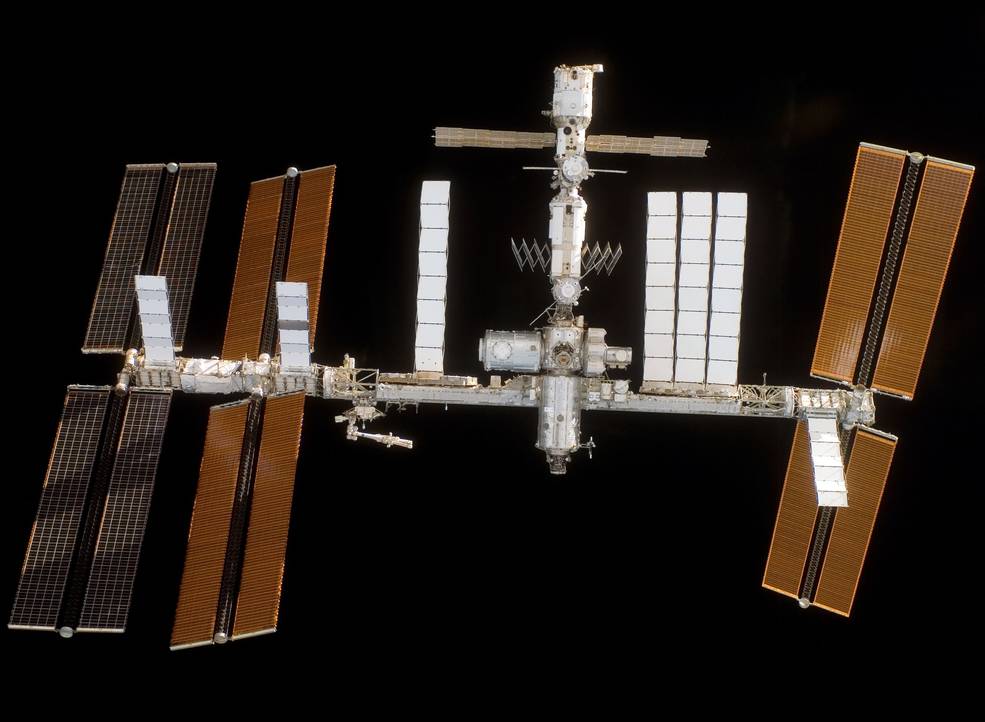
Left: Zamka holding the cufflink device used to repair the torn solar array.
Middle: Zamka, lower right, with the STS-120 and Expedition 16 crews.
Right: ISS as seen from STS-120 departing, showing the newly-delivered Harmony Node 2 temporarily berthed at the Unity Node 1 and the relocated and redeployed P6 truss segment and solar arrays at left.
When he returned to ISS, Zamka did so as Commander of Endeavour’s STS-130 mission, launched on Feb. 8, 2010. After guiding the shuttle to a successful docking with ISS, Zamka and his crewmates, along with the Expedition 22 crew, installed the Tranquility Node 3 module to Unity’s port side and activated the new element. The new module provided accommodations for life support and habitation facilities for a six-person crew on ISS. The crew removed the Cupola from its launch position at the end of Tranquility and relocated it to the module’s Earth-facing port. The Cupola’s six trapezoidal and one circular center window provide crews not only visibility for approaching visiting vehicles, but also spectacular views of their home planet passing by below.
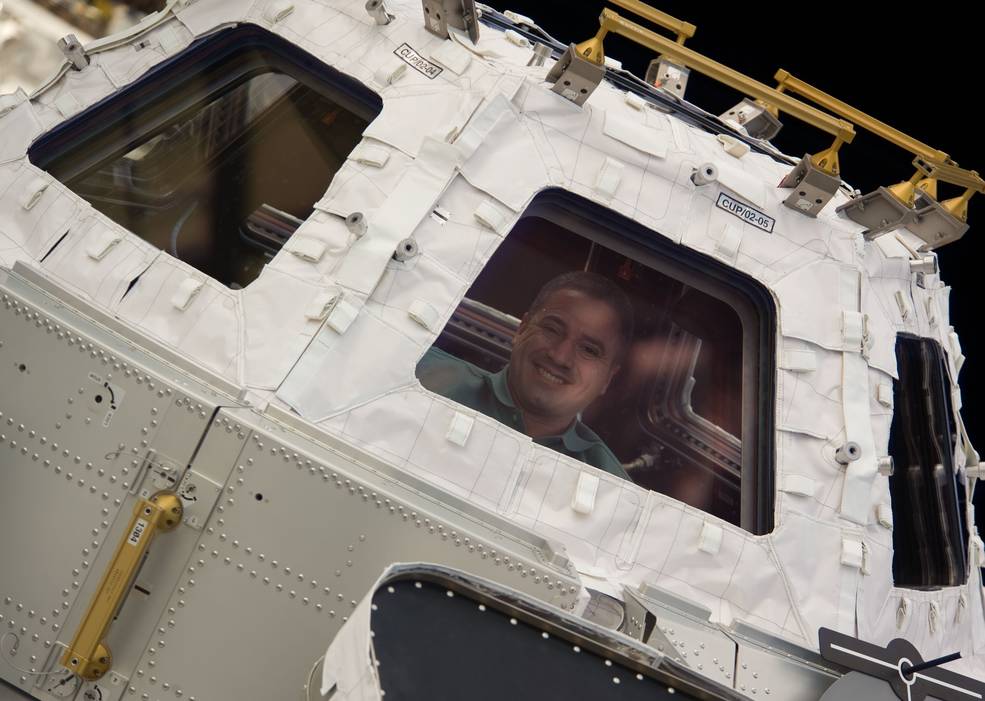
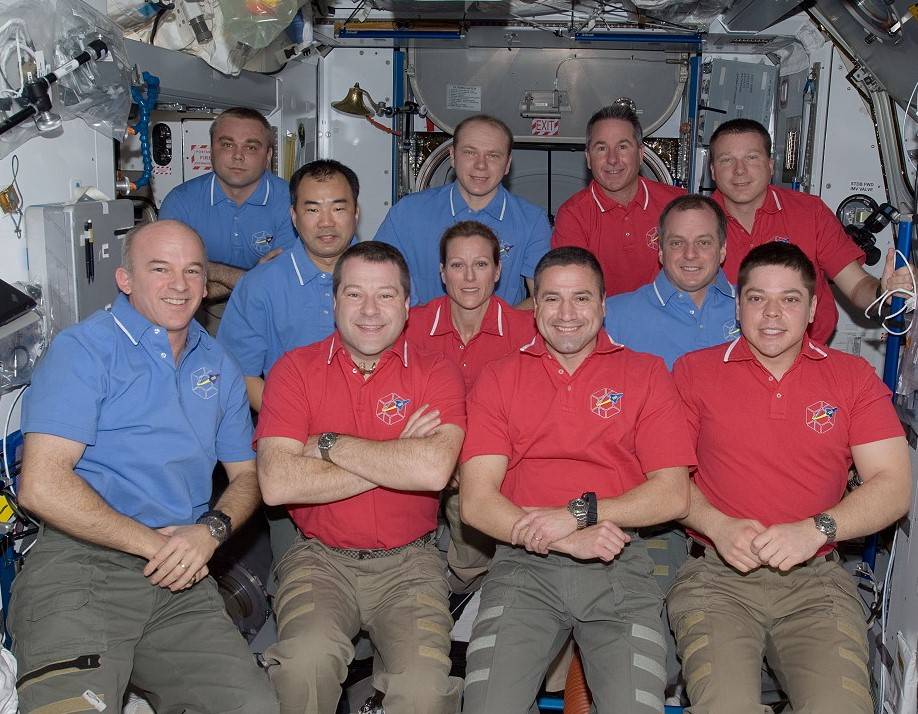
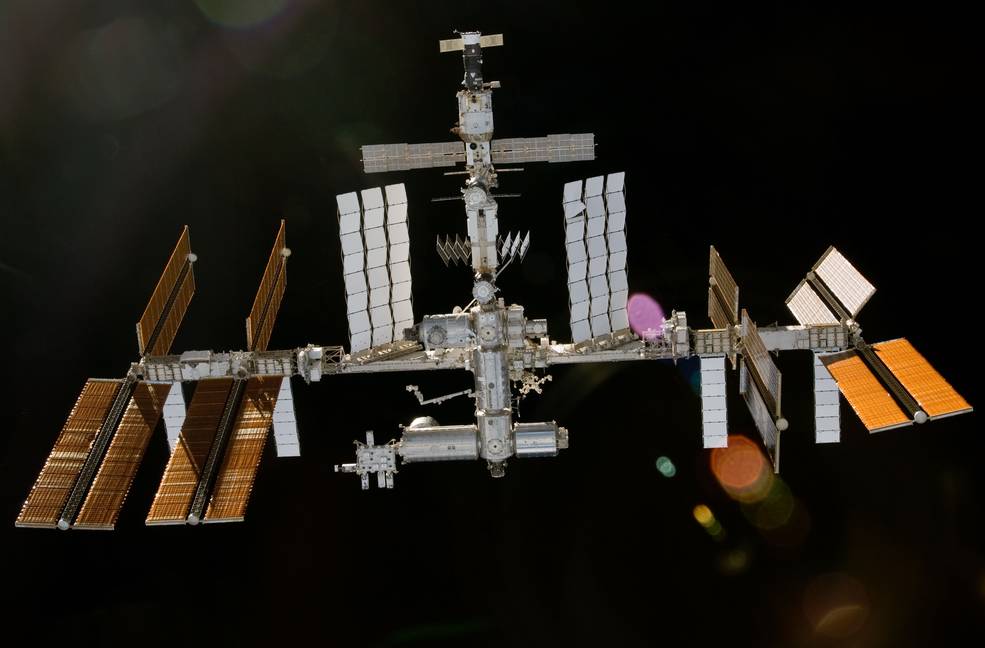
Left: Zamka peering through one of the Cupola’s windows.
Middle: Zamka, front row second from right, with the STS-130 and Expedition 22 crews.
Right: ISS as seem from the departing STS-130, showing the Tranquility Node 3 and Cupola berthed at the Unity Node 1, left of center.
Joseph M. “Joe” Acaba was selected in 2004 as part of NASA’s Educator Astronaut Program and qualified as a mission specialist. His first flight into space was aboard STS-119, launched on March 15, 2009. Discovery brought up the S6 final truss segment with the fourth and final set of solar arrays, bringing the US segment of the station’s useable power generating capability to between 42 and 60 kilowatts. Acaba completed two of the mission’s three EVAs, one with fellow mission specialist Steven R. Swanson and the other with fellow educator-astronaut and mission specialist Richard R. “Ricky” Arnold. During the STS-119 mission, Koichi Wakata replaced Sandra H. Magnus as a member of the Expedition 18 crew.
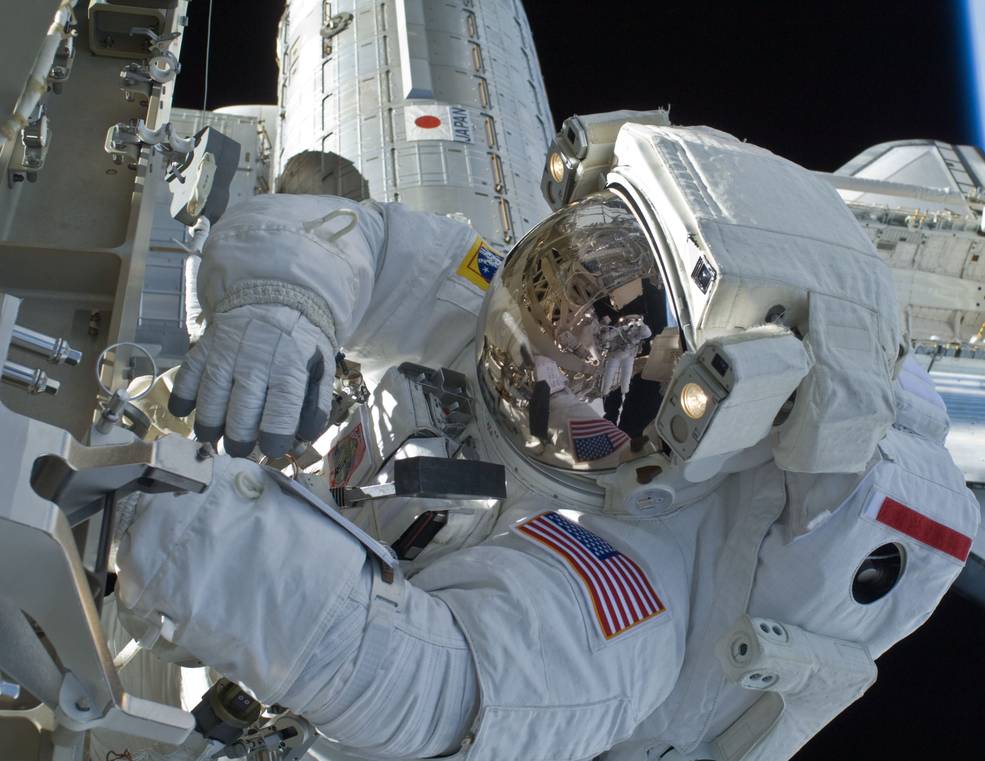
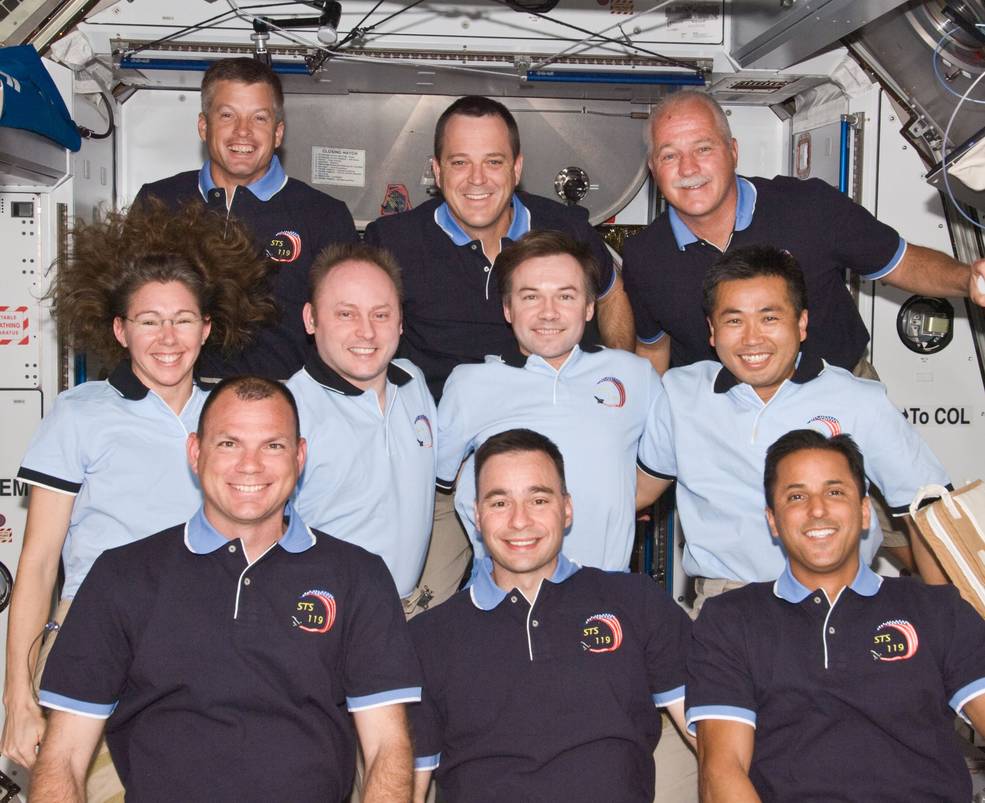
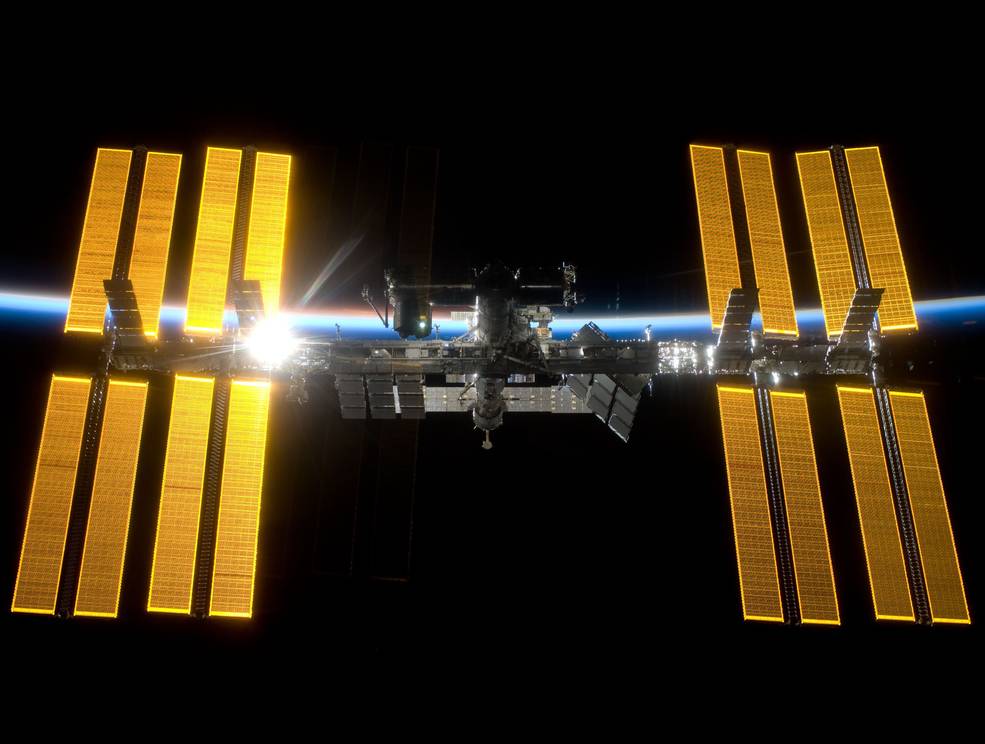
Left: Acaba during the third STS-119 EVA.
Middle: Acaba, front row at right, with the STS-119 and Expedition 18 crews.
Right: ISS as seen from the departing STS-119, with the newly-added S6 truss segment and solar arrays, at right.
For his second visit to ISS, Acaba stayed for 125 days as part of Expeditions 31 and 32, launching from Kazakhstan aboard Soyuz TMA-04M with Gennadi I. Pakalka and Sergey N. Revin on May 15, 2012. They joined Oleg D. Kononenko, Donald R. Pettit, and André Kuipers who had been aboard ISS since the previous December. A week after their arrival, Acaba and his crewmates welcomed the first commercial vehicle to dock with ISS, the SpaceX Dragon cargo resupply vehicle on its Demo 2 mission, carrying 1,150 pounds of food, water, scientific experiments, and other items. The Expedition 31 crew loaded the Dragon spacecraft with nearly 1,500 pounds of cargo and experiment samples for return to Earth. The crew observed and photographed a rare celestial event, a transit of Venus across the Sun on June 5. Kononenko, Pettit, and Kuipers returned to Earth July 1, replaced by Suni Williams, Yuri Malenchenko, and Akihiko Hoshide on July 17 as the new members of Expedition 32. In addition to conducting numerous science experiments, Acaba helped fire prevention icon Smokey the Bear celebrate his 68th birthday. Acaba, Padalka and Revin returned to Earth on Sept. 16.
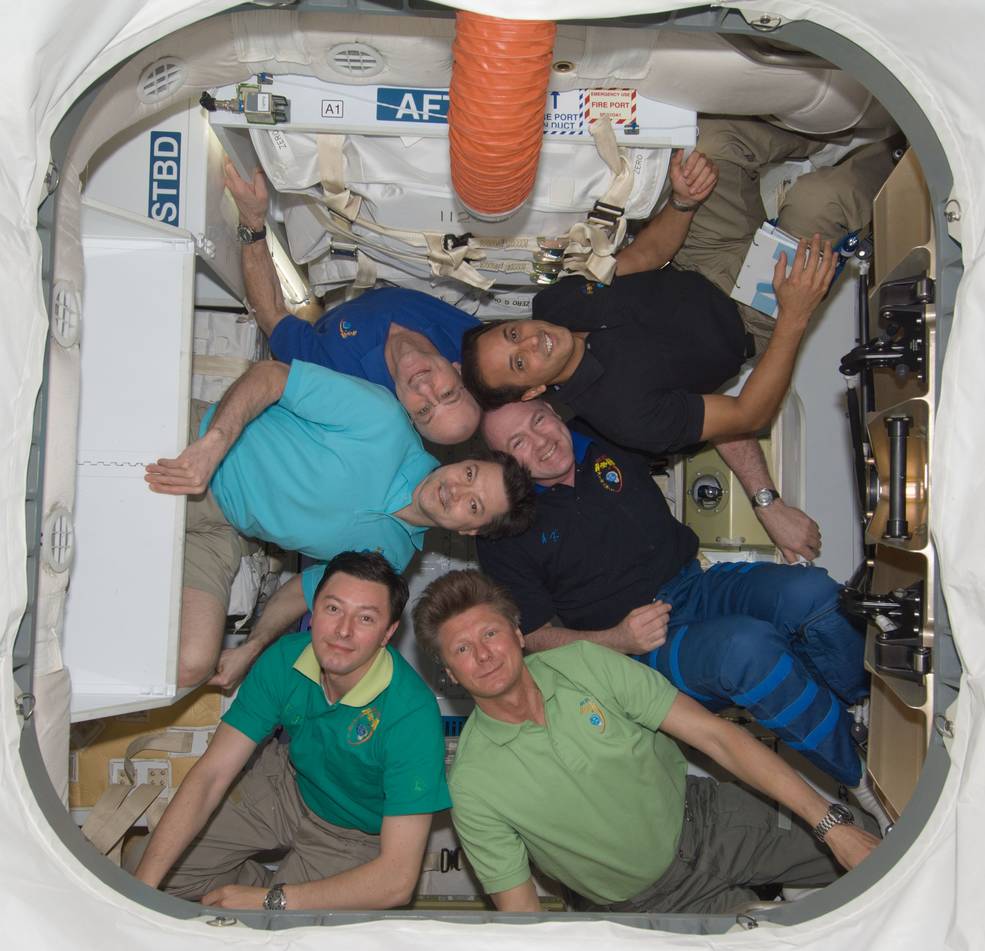
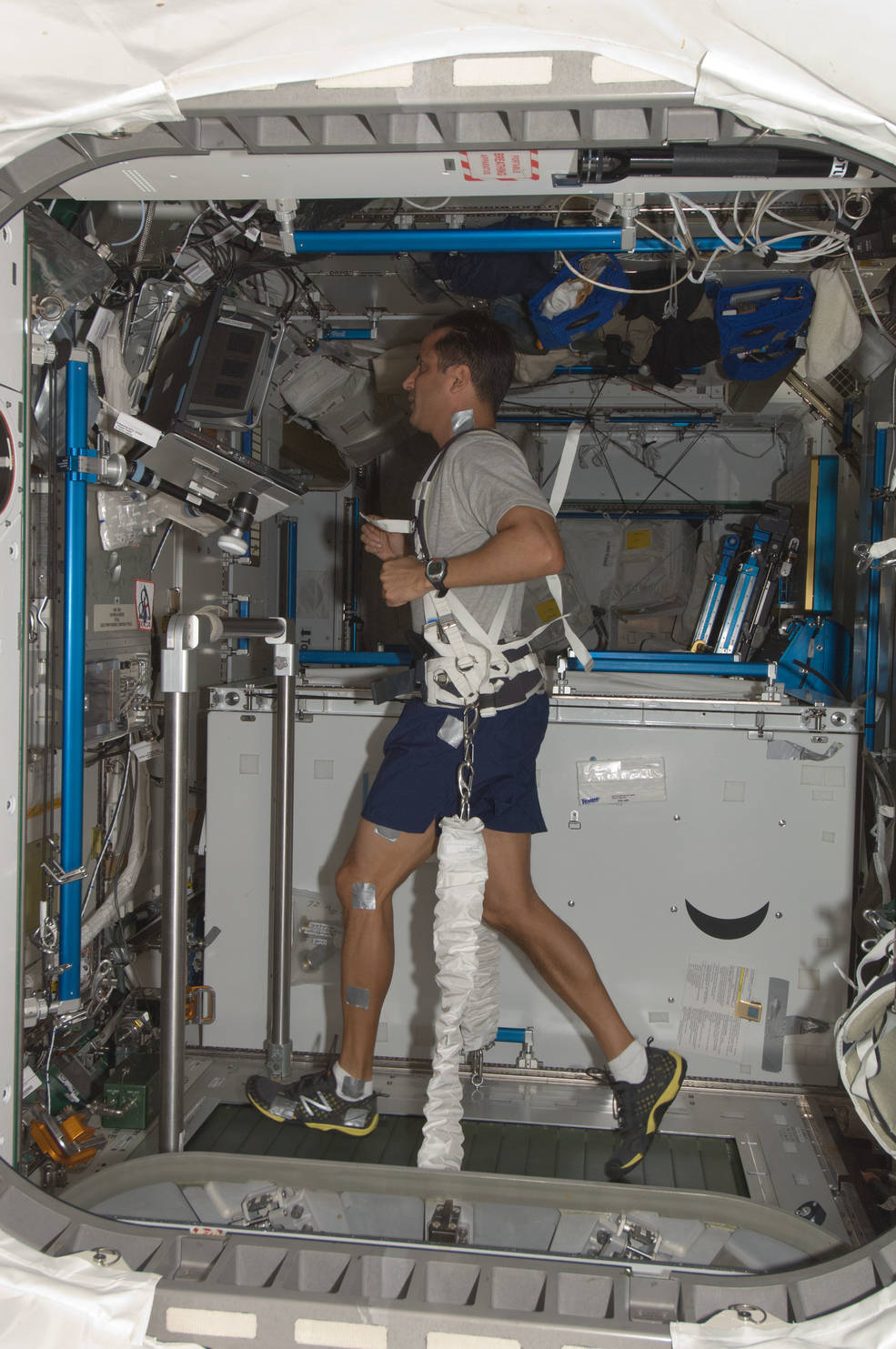
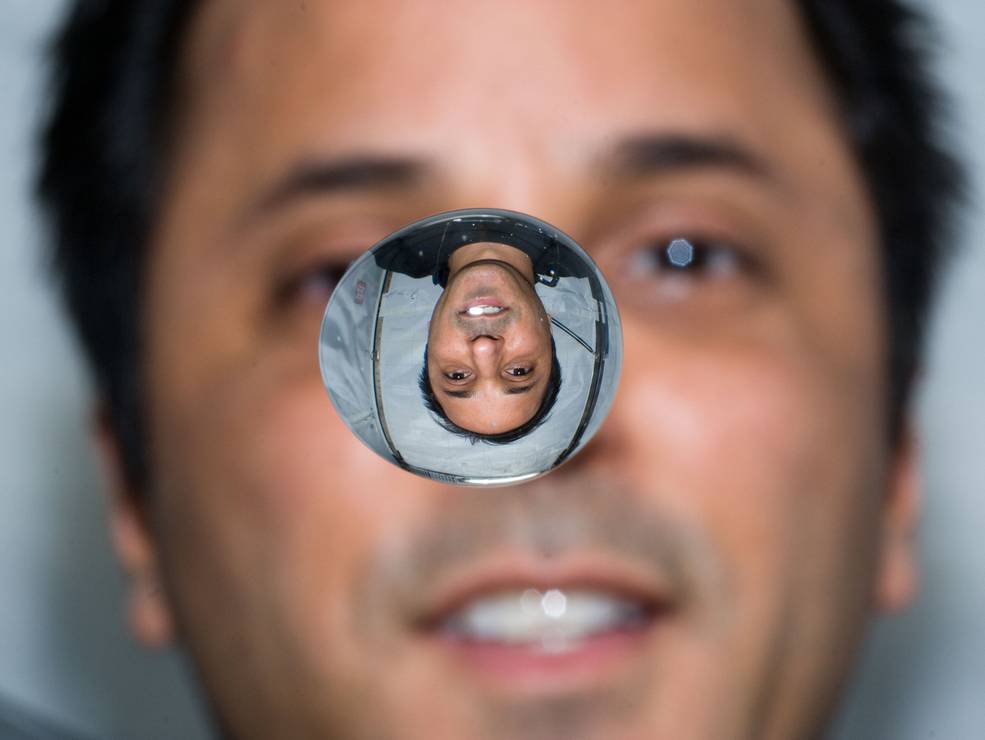
Left: Acaba, top right, with his Expedition 31 crewmates aboard the SpaceX Dragon resupply
vehicle.
Middle: Acaba running on COLBERT.
Right: Acaba reflected in a globule of water.
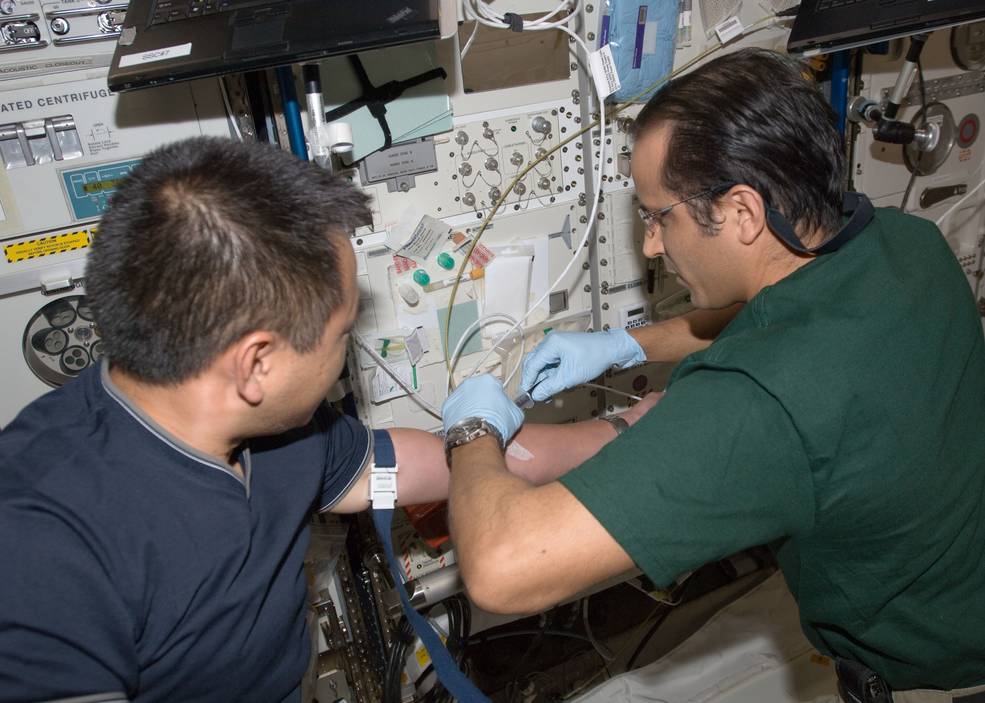
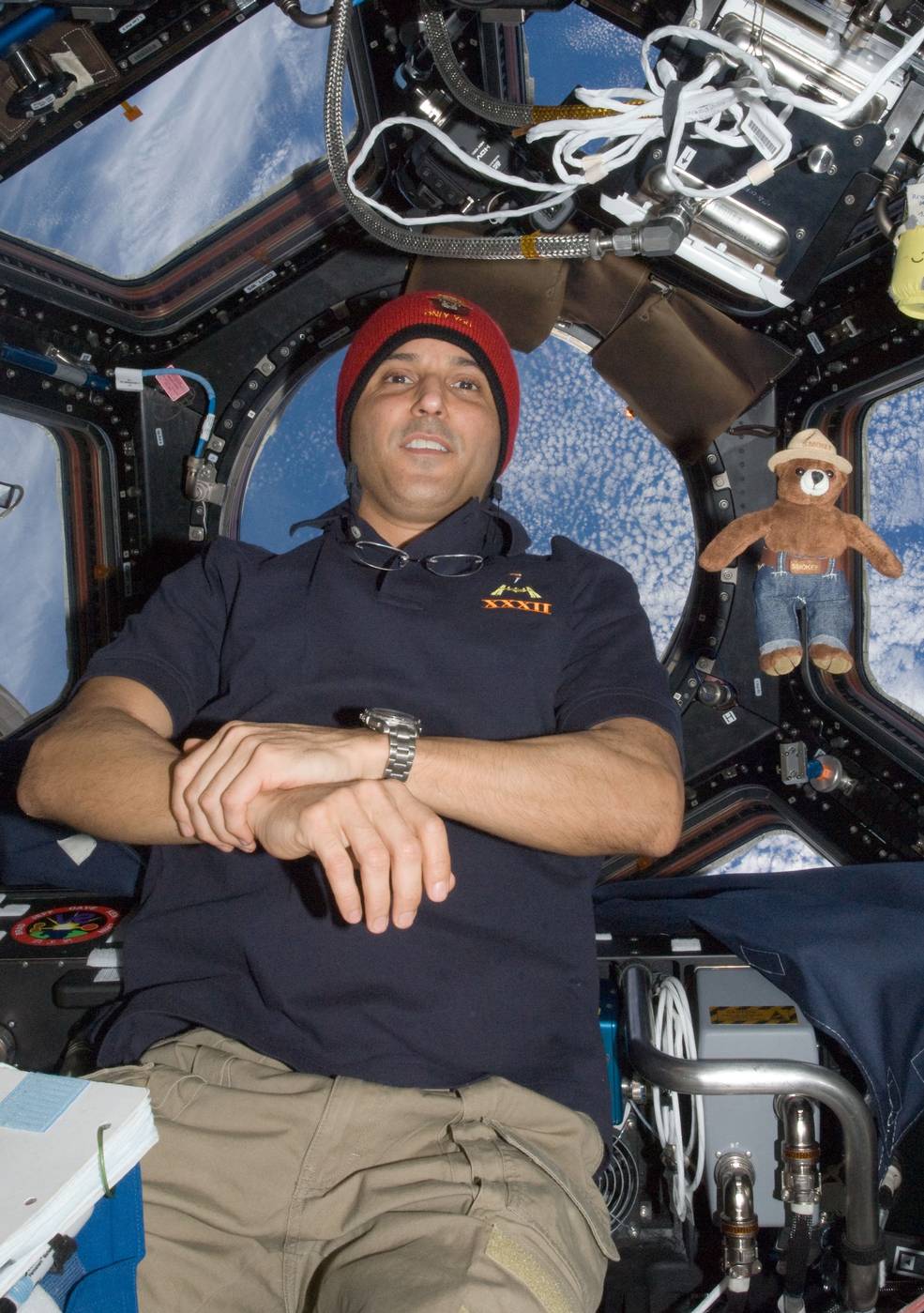
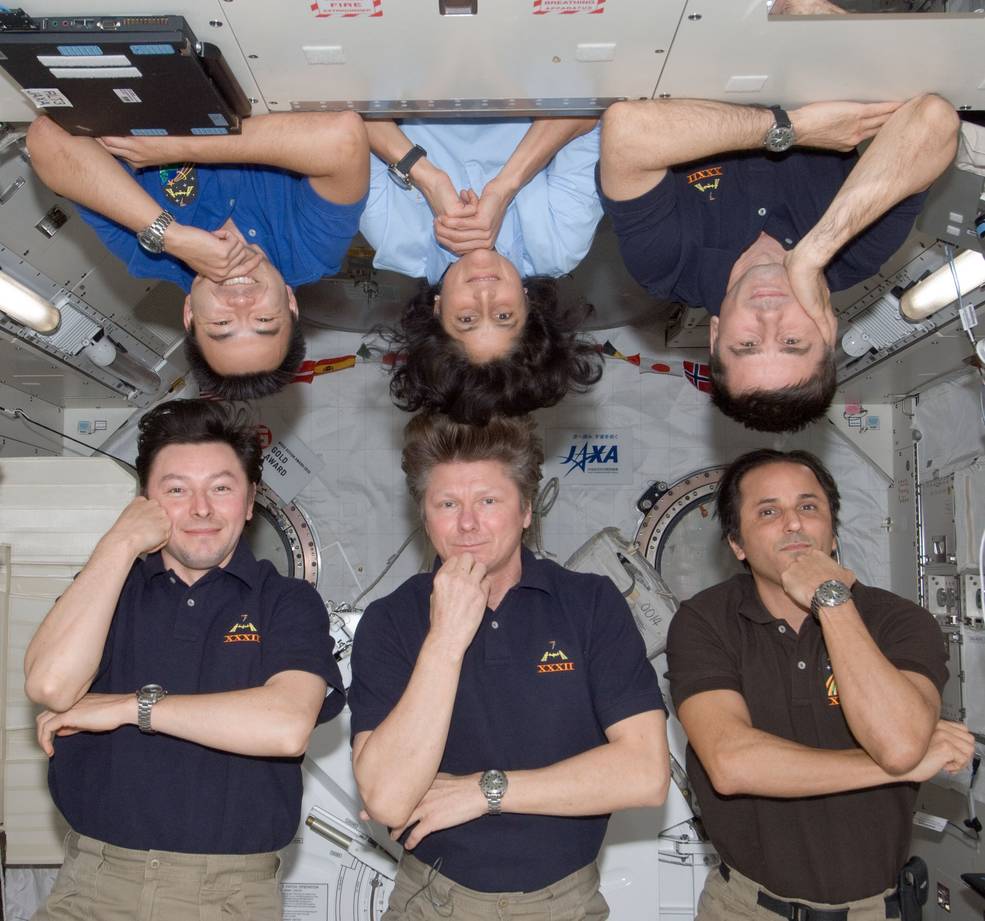
Left: Acaba, right, drawing a blood sample from Hoshide.
Middle: Acaba with a toy Smokey the Bear in the Cupola to help celebrate the forest fire prevention icon’s 68th birthday.
Right: Acaba, lower right, with this Expedition 32 crewmates.
Acaba returned to ISS five years later as a member of Expedition 53 and 54, launching on Sept. 12, 2017, aboard Soyuz MS-06 with Aleksandr A. Misurkin and Mark T. Vande Hei. They joined Randolph J. “Randy” Bresnik, Sergei N. Ryazanski, and Paolo A. Nespoli who had been aboard ISS since July. Acaba joined Bresnik for a nearly seven-hour EVA on Oct. 20 to lubricate the newly installed replacement Latching End Effector on the SSRMS. Bresnik, Ryazanski, and Nespoli returned to Earth on Dec. 14, replaced aboard ISS five days later by Anton N. Shkaplerov, Scott D. Tingle, and Norishige Kanai to complete the Expedition 54 crew. Acaba continued with the research program and celebrated his Puerto Rican heritage with several events. He returned to Earth with Misurkin and Vande Hei on Feb. 28, 2018, after a 168-day flight. Over his three missions, Acaba accumulated 306 days in space and nearly 20 hours in EVA time.
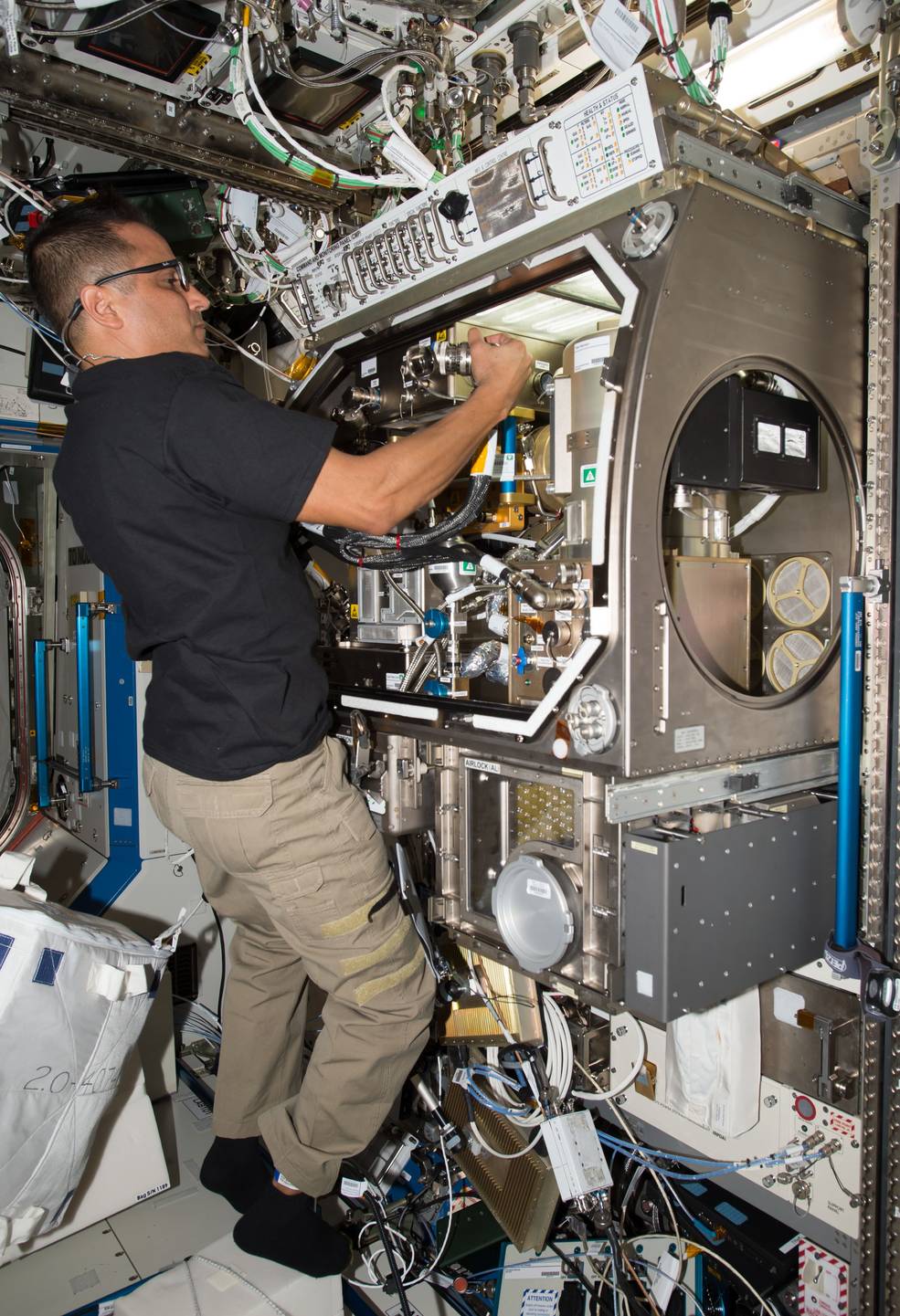
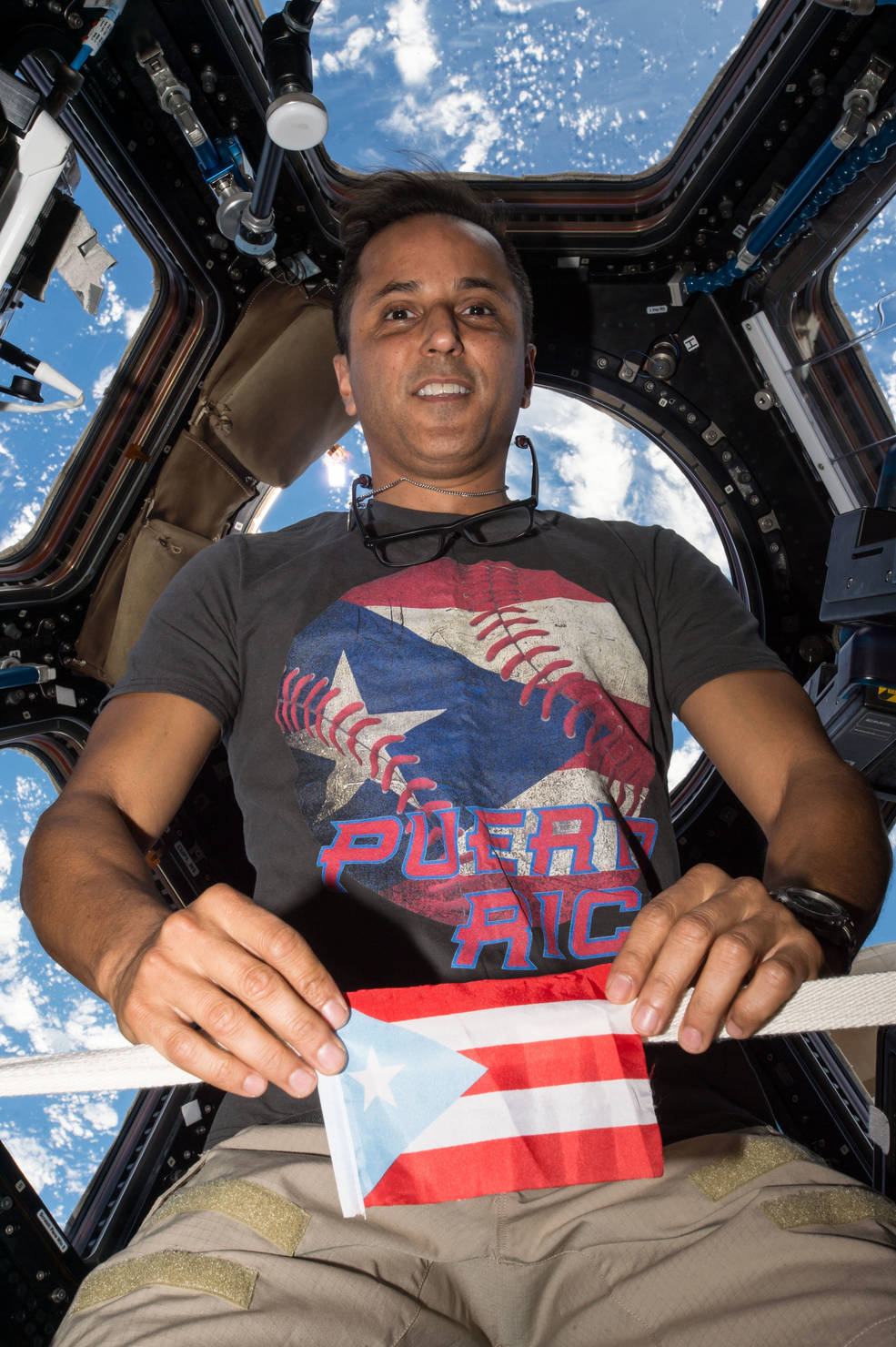
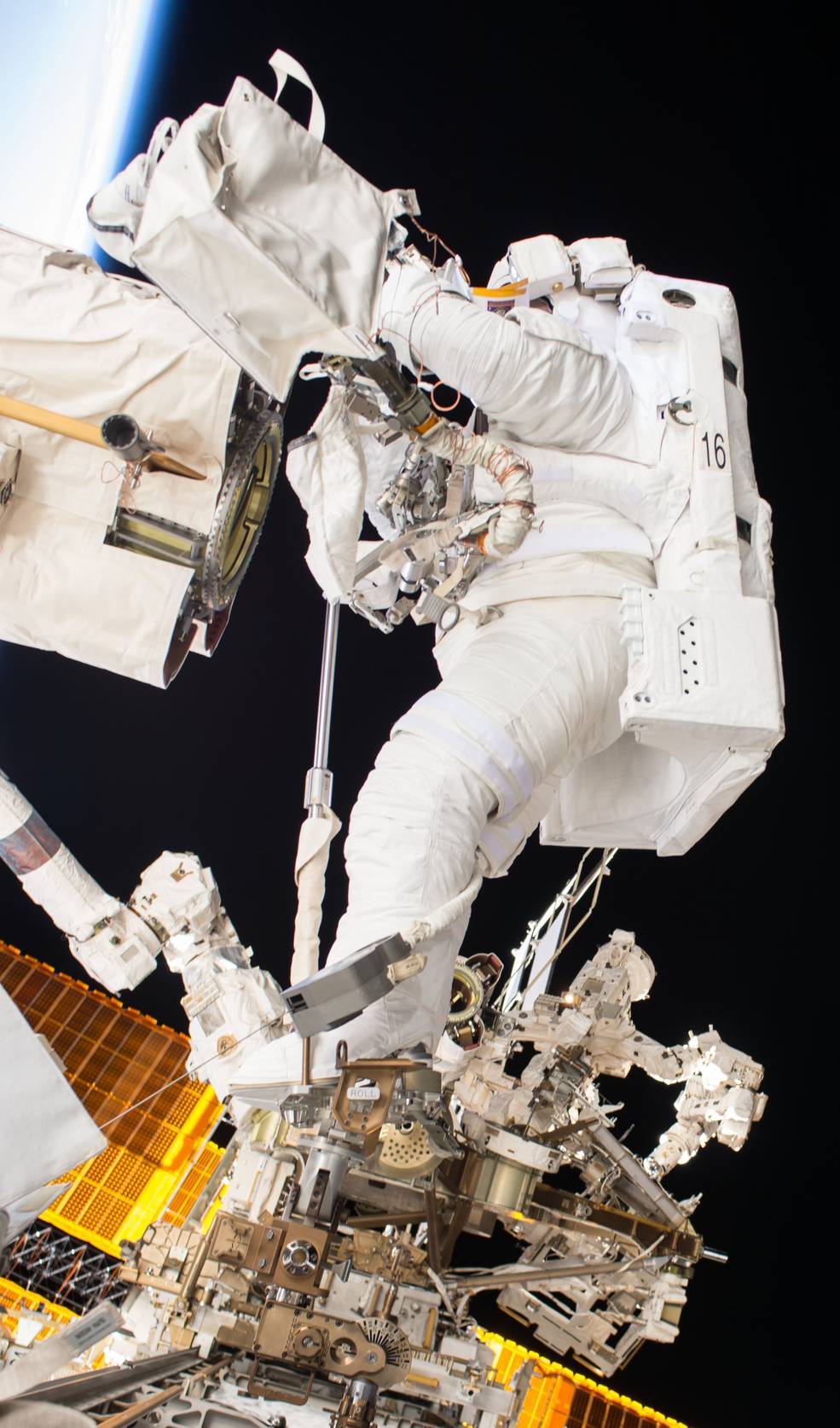
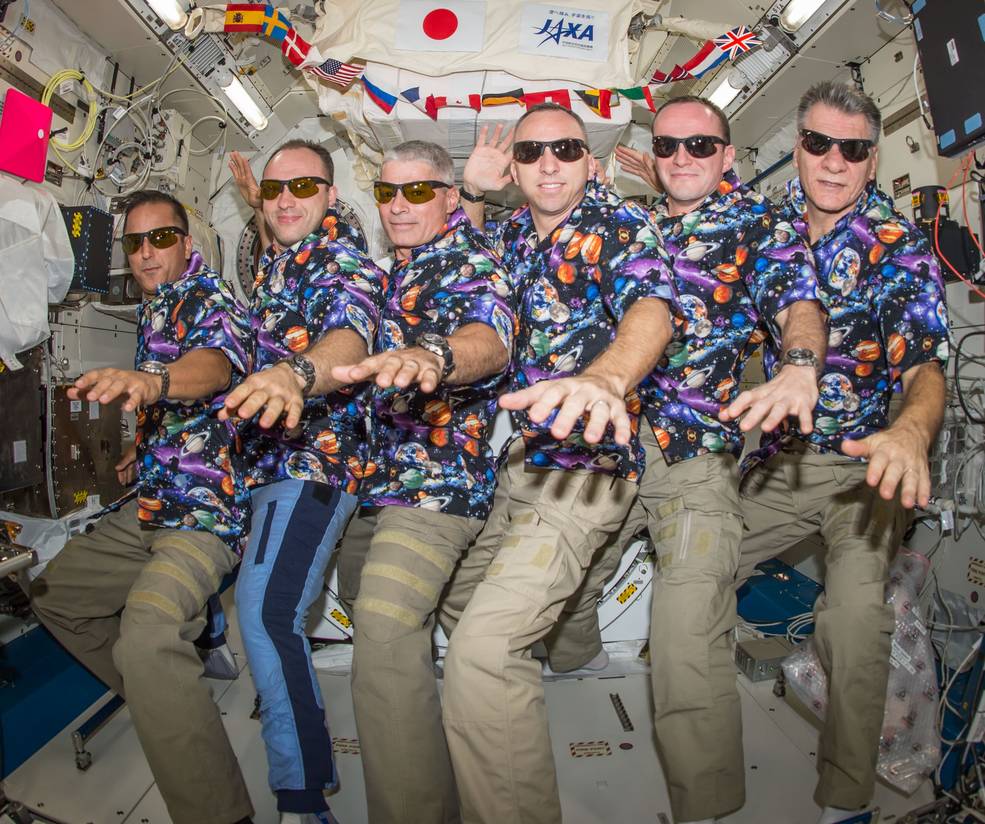
Left: Acaba conducting an experiment in the MSG.
Middle left: In the Cupola, Acaba showing Puerto Rico pride.
Middle right: During an EVA, Acaba is lubricating the SSRMS Latching End Effector.
Right: Acaba, left, with his Expedition 53 crewmates.
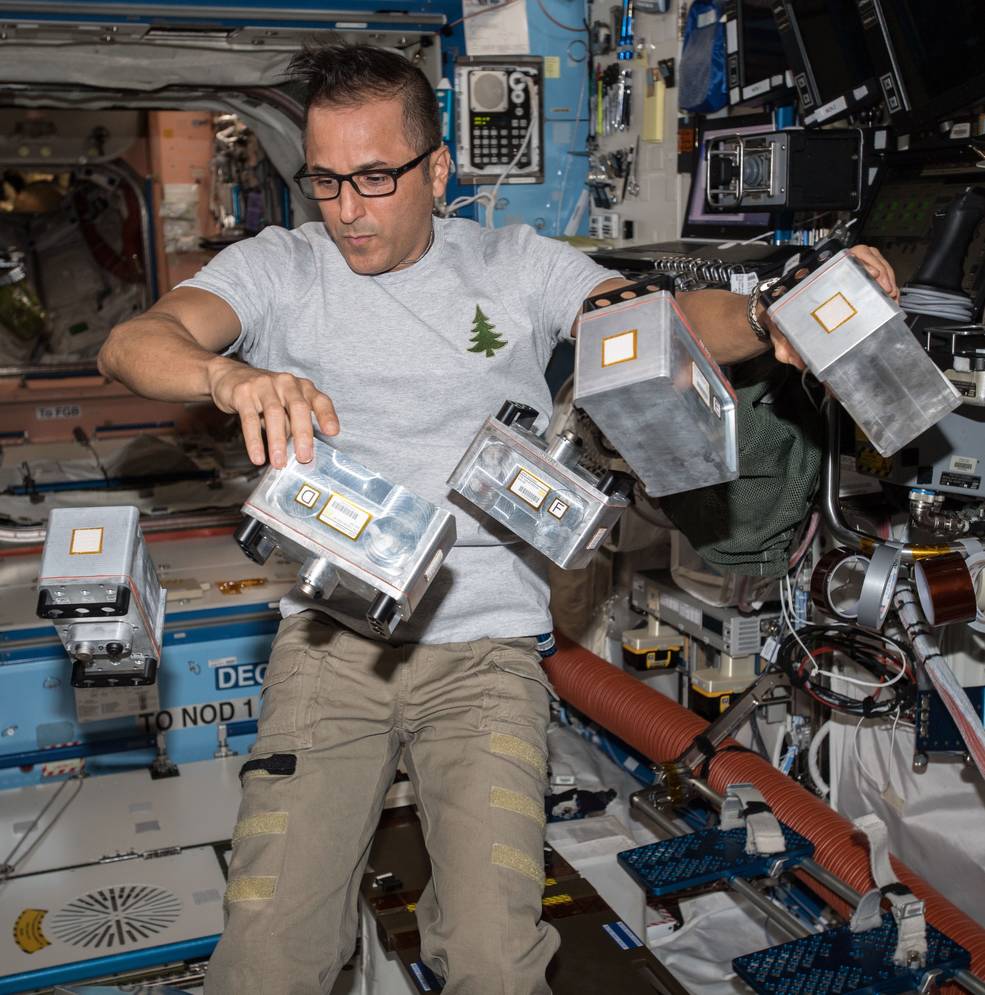
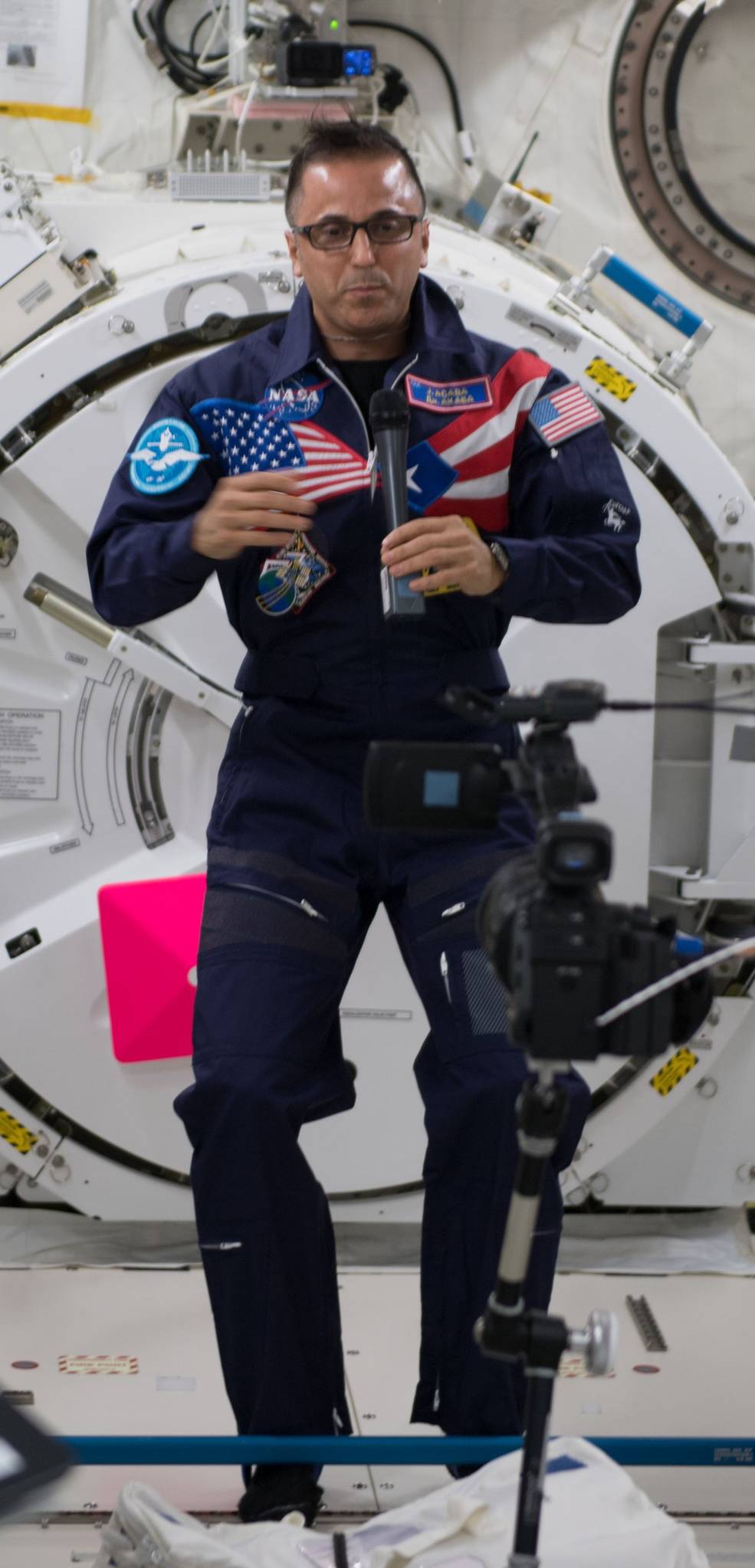
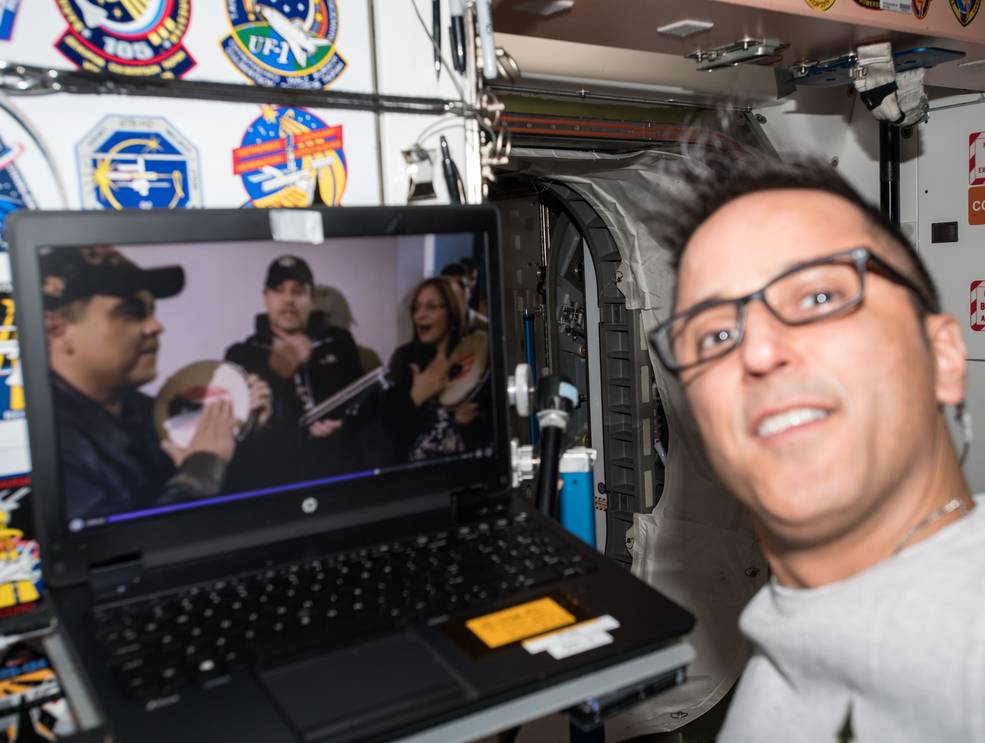
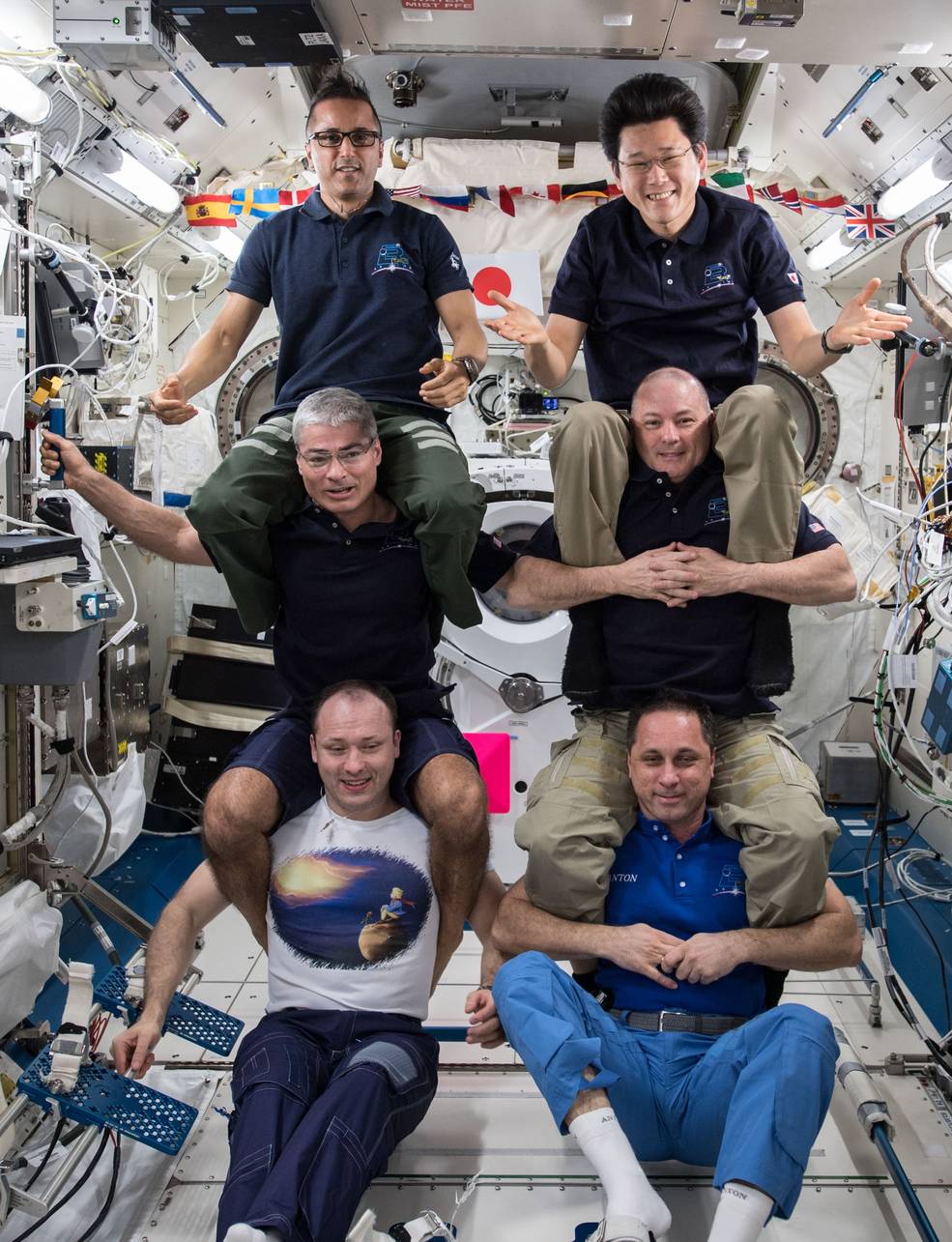
Left: Acaba working with the Biological Research in Canisters (BRIC) experiment.
Middle left: Acaba speaking with the Puerto Rico Institute of Robotics.
Middle right: During the holidays, Acaba participating in a parranda by video.
Right: Acaba, upper left, with his Expedition 54 crewmates.
Selected in 2004 as a NASA astronaut, José M. Hernández made his single visit to ISS during the STS-128 mission. Launched aboard Discovery on Aug. 29, 2009, Hernández operated both the shuttle and ISS robotic arms to move the MPLM Leonardo back and forth and translate astronauts during the mission’s three EVAs. He participated in the transfer and installation of the three systems racks (CQ, ARS, and COLBERT) and the three research racks (FIR, MSRR, and MELFI-2) aboard ISS. STS-128 also completed the final shuttle-based crew exchange, with Stott replacing Kopra as an Expedition 20 crewmember.
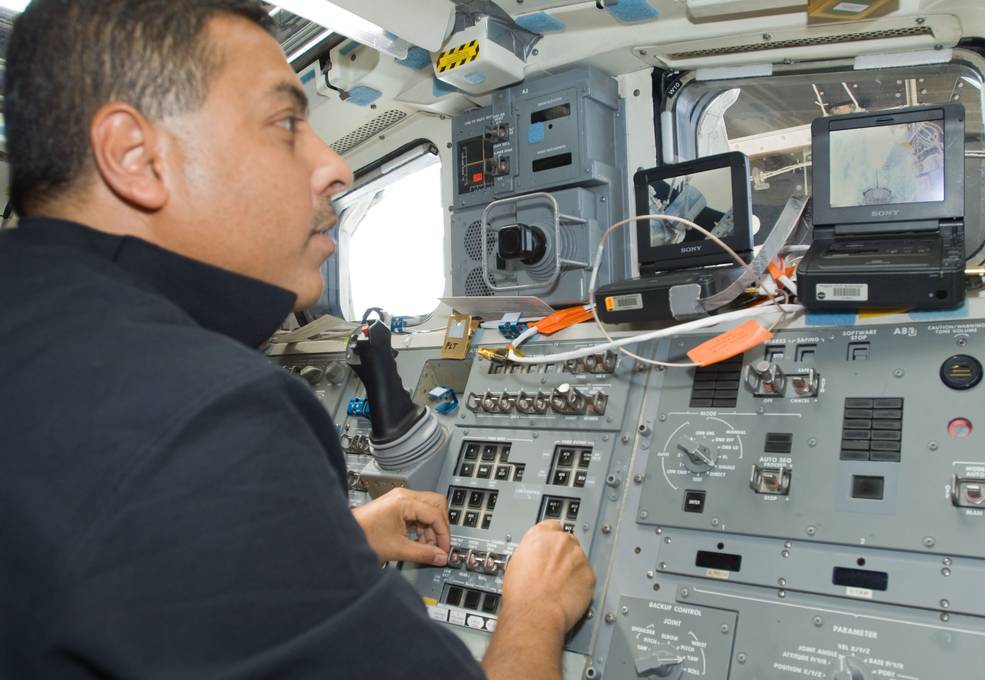
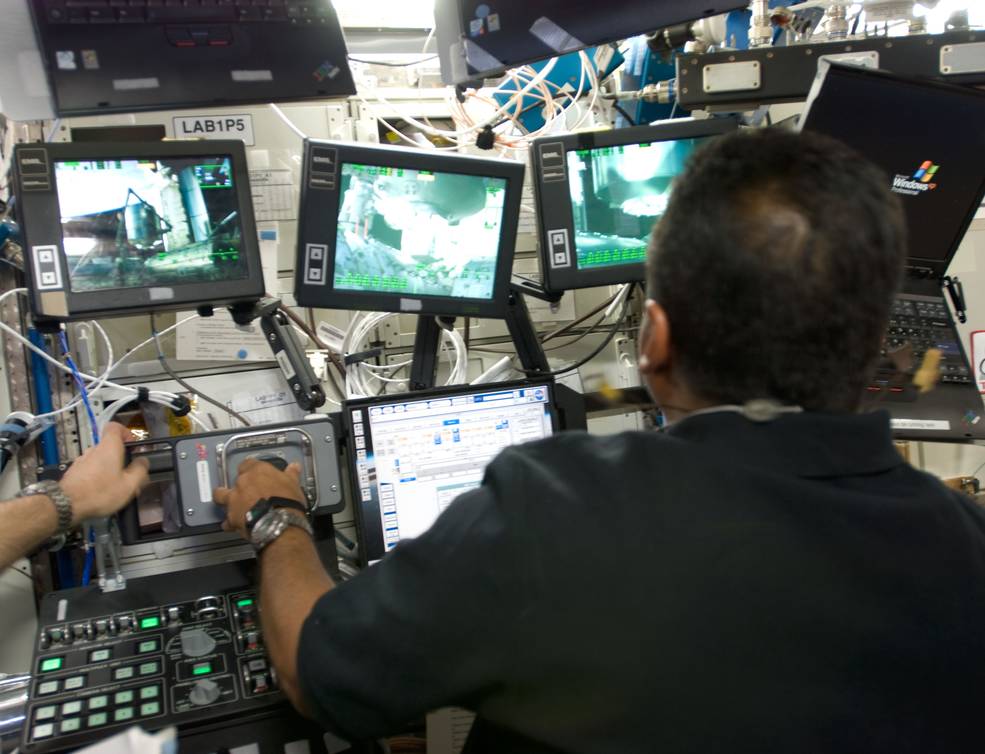
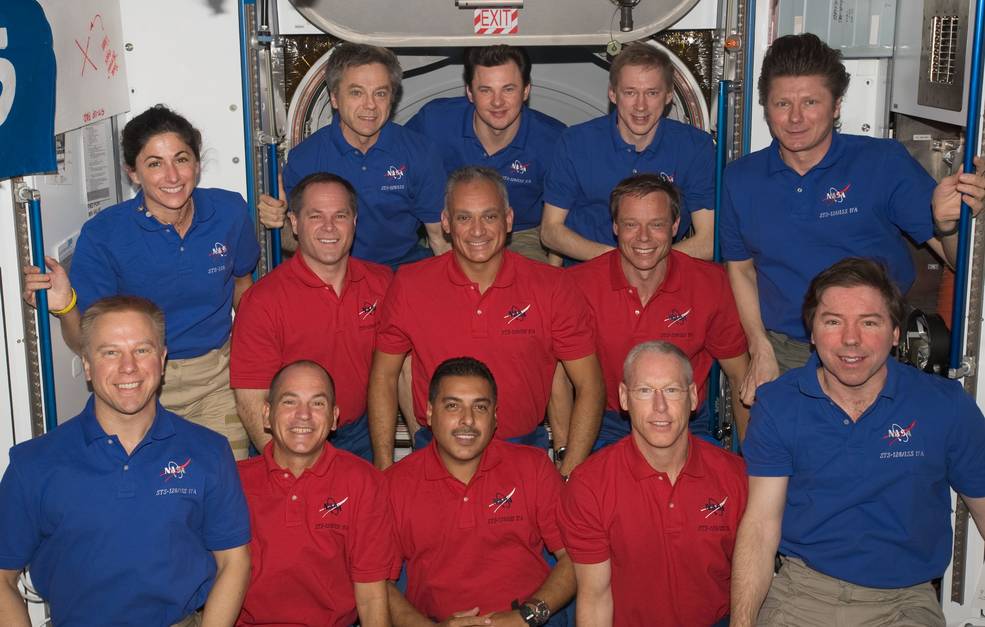
Left: Hernández operating the shuttle’s robotic arm to transfer the MPLM to ISS.
Middle: Hernández operating the ISS robotic arm to return the MPLM to the shuttle’s payload bay.
Right: Hernández, front row center, with the STS-128 and Expedition 20 crews.
Serena M. Auñón-Chancellor was selected as a member of NASA’s Astronaut Class of 2009 and made her first spaceflight nine years later. Launched aboard Soyuz MS-09 with Sergei V. Prokopiev and Alexander Gerst on June 6, 2018, she joined Andrew J. Feustel, Oleg G. Artemev, and Ricky Arnold, already on board ISS since March of that year. Auñón-Chancellor began work on the more than 300 research investigations she carried out during her stay aboard ISS. Feustel, Artemev, and Arnold returned to Earth Aug. 4, and would have been replaced by Aleksei N. Ovchinin and T. Nicklaus “Nick” Hague on Oct. 11, but their booster malfunctioned during launch, forcing an emergency abort landing. The next crew of Oleg D. Konoenko, David Saint-Jacques, and Anne C. McClain didn’t arrive until Dec. 3. Auñón-Chancellor and her crewmates returned to Earth on Dec. 20 after a 197-day flight.
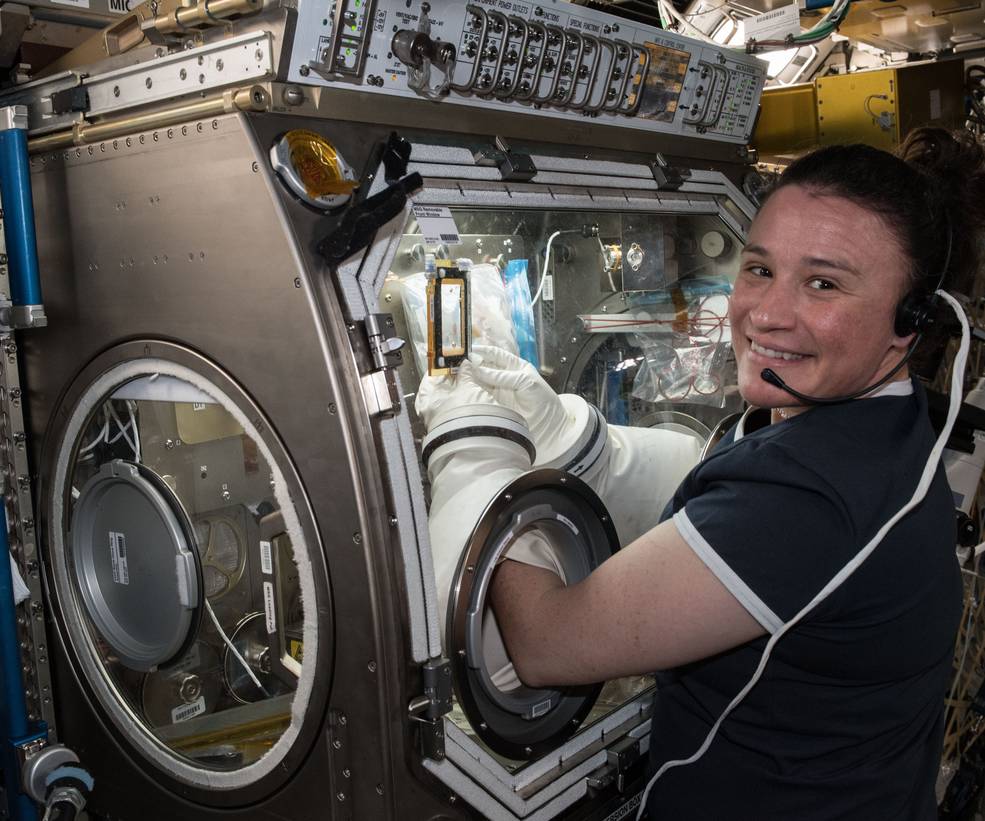
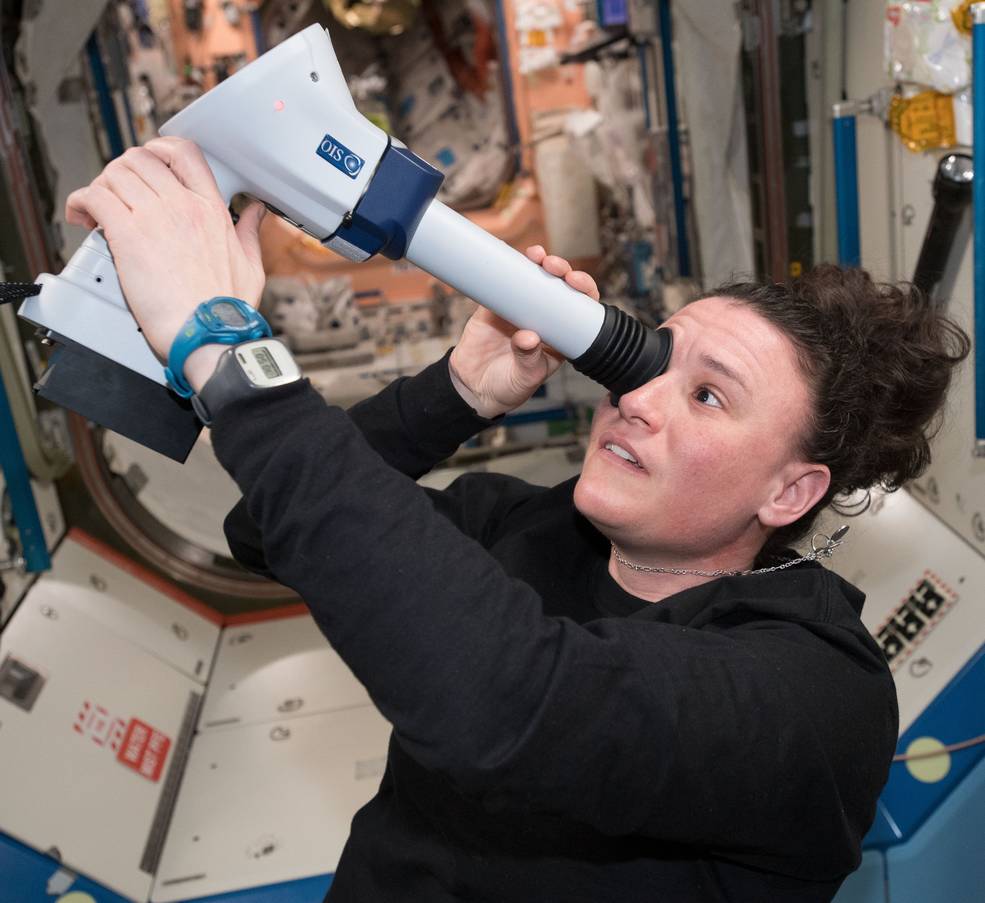
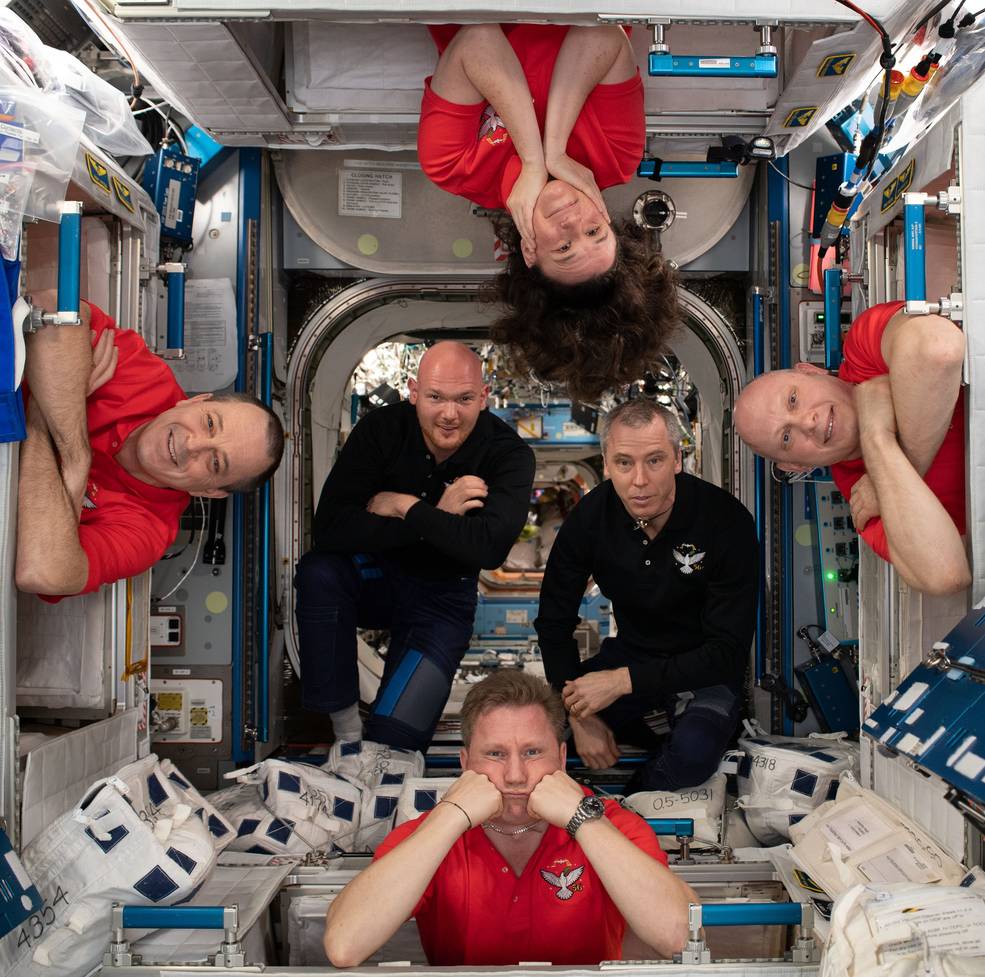
Left: Auñón-Chancellor conducting the AngieX Cancer Therapy experiment in the MSG.
Middle: Auñón-Chancellor completing a session of the Eye Exam – Fundoscope experiment to help understand vision changes.
Right: Auñón-Chancellor, top, posing with her Expedition 56 crewmates in the Harmony Node 2 module.
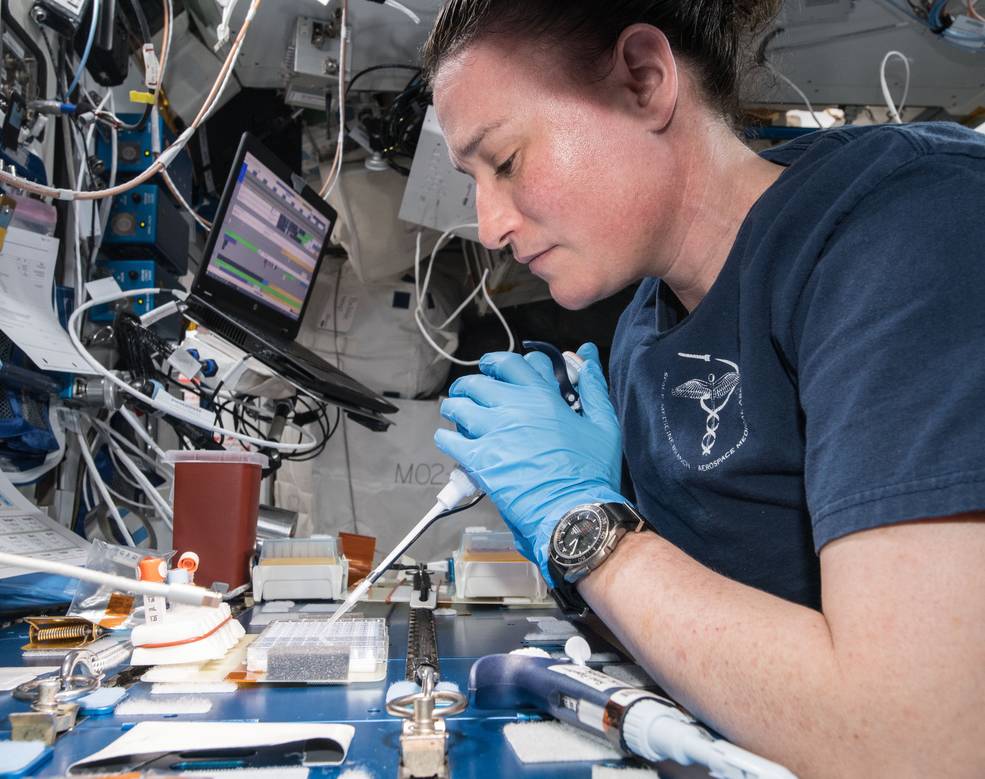
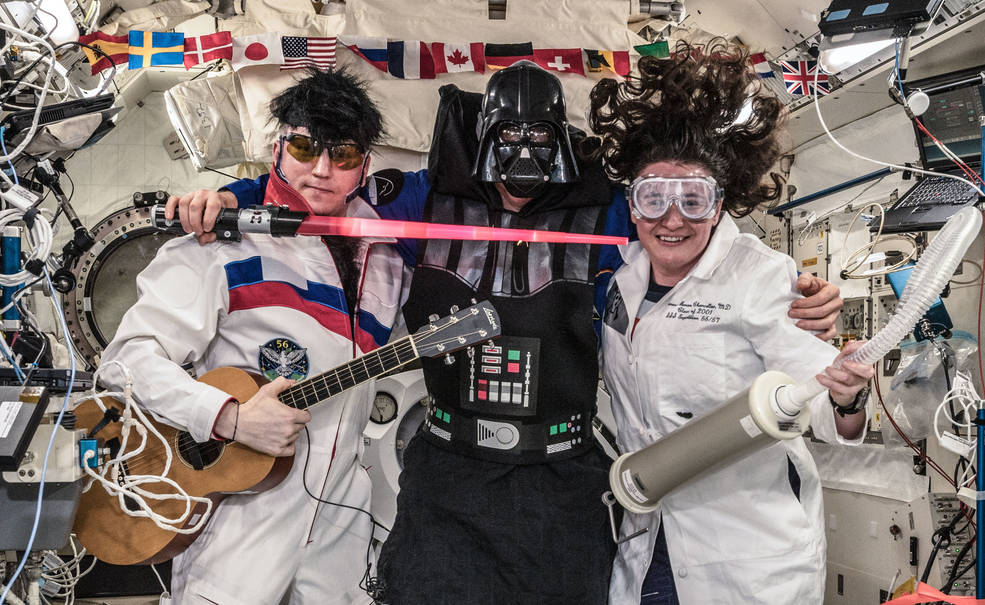
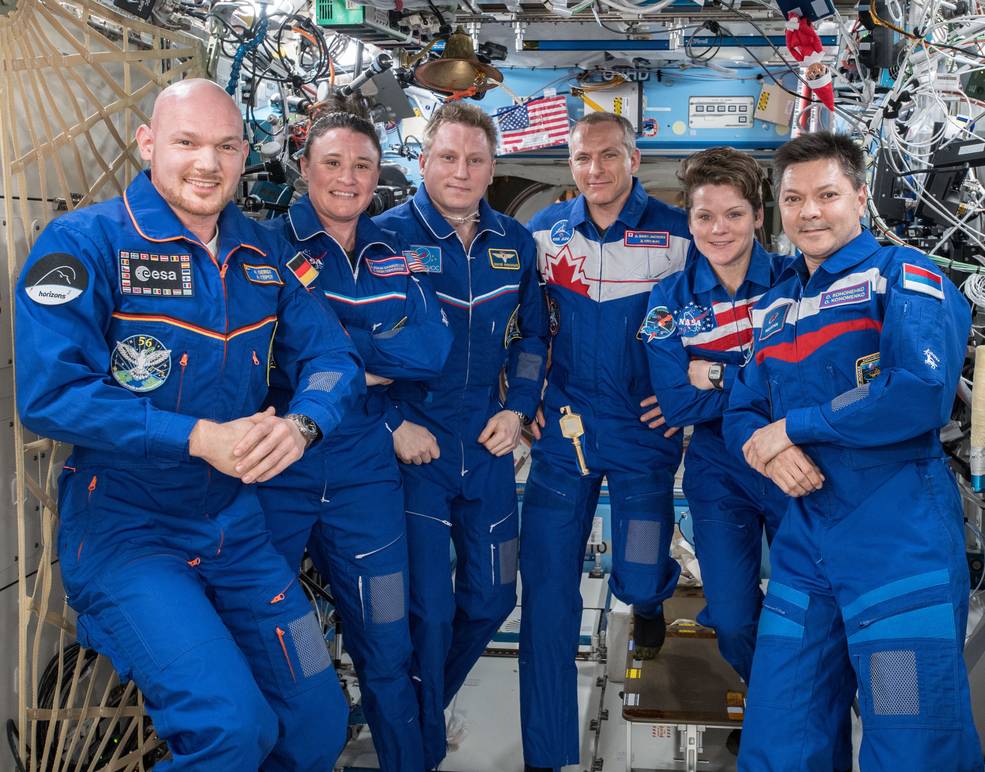
Left: Auñón-Chancellor working on the BioServe Protein Crystalography-1 (BPC-1) experiment.
Middle: Expedition 57 crewmembers in their best Halloween outfits – Prokopiev, left, as Elvis, Gerst
as Darth Vader, and Auñón-Chancellor as a mad scientist. Right: Auñón-Chancellor and
her Expedition 57 crewmates in the Destiny module.
One additional crewmember deserves recognition in this tribute to Hispanic astronauts. Although he never flew to ISS, in fact, his spaceflight took place 15 years before the first crew arrived aboard the space station, he made a lasting contribution to astronaut diets aboard both the space shuttle and ISS. In November 1985, Mexican Payload Specialist Rodolfo Neri Vela, who was a crewmember aboard Atlantis during the STS-61B mission, requested that tortillas be included in his food supply. Once on orbit, his fellow crewmembers noticed that the tortillas, unlike regular bread, didn’t create crumbs and could be used to make sandwiches or hold other food items. Since that mission, tortillas have been a favorite of crewmembers of all nationalities and are standard fare aboard ISS. Crewmembers use them to make breakfast burritos, hamburgers, and even peanut butter and jelly sandwiches, as demonstrated by Expedition 50 Commander R. Shane Kimbrough.
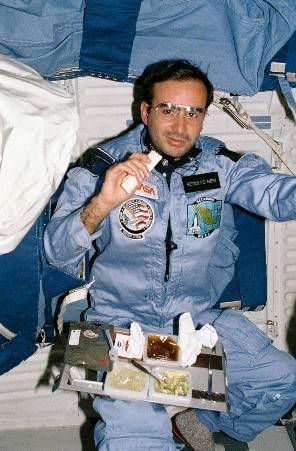
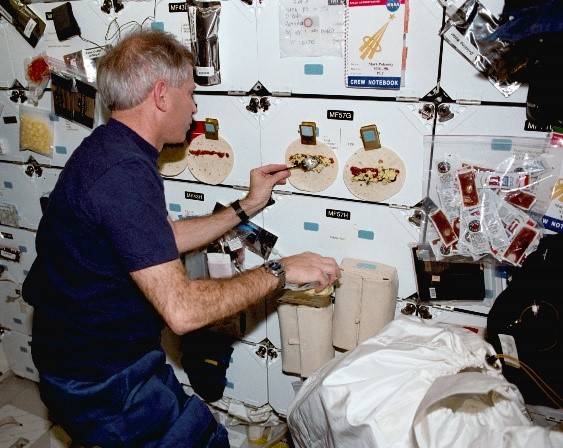
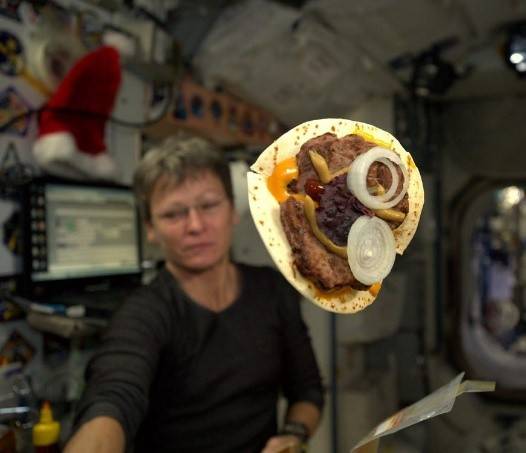
Left: Payload Specialist Neri Vela enjoying a trend-setting tortilla aboard Atlantis in 1985.
Middle: STS-98 Pilot Kenneth D. Cockrell preparing breakfast burritos for his crewmates.
Right: Expedition 51 Commander Peggy A. Whitson showing off the hamburger she prepared
using a tortilla.
To be continued…
John Uri
NASA Johnson Space Center


























